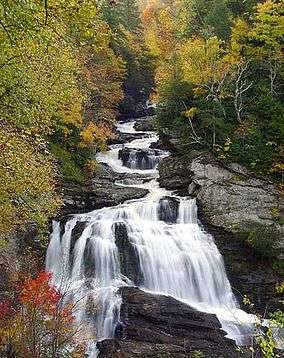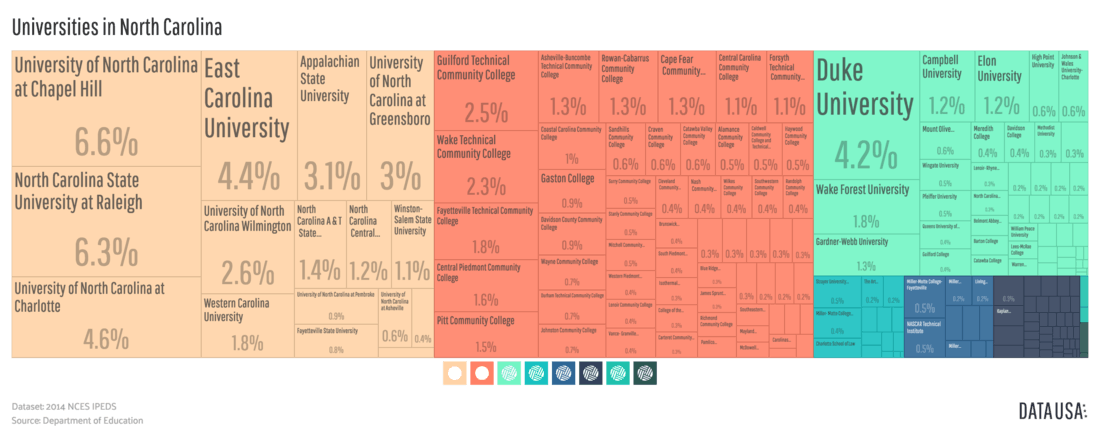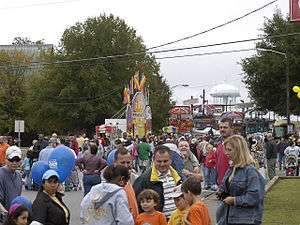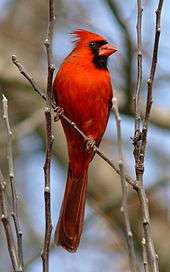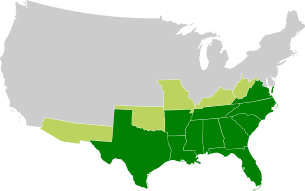North Carolina
North Carolina (/ˌkærəˈlaɪnə/ (![]()
North Carolina | |
|---|---|
| State of North Carolina | |
| Nickname(s): Old North State; Tar Heel State | |
| Motto(s): | |
| Anthem: The Old North State | |
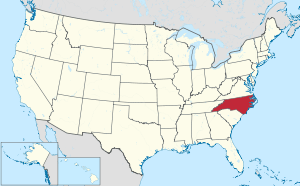 Map of the United States with North Carolina highlighted | |
| Country | United States |
| Before statehood | Province of North-Carolina |
| Admitted to the Union | November 21, 1789 (12th) |
| Capital | Raleigh |
| Largest city | Charlotte |
| Largest metro | Greater Charlotte |
| Government | |
| • Governor | Roy Cooper (D) |
| • Lieutenant Governor | Dan Forest (R) |
| Legislature | General Assembly |
| • Upper house | Senate |
| • Lower house | House of Representatives |
| Judiciary | North Carolina Supreme Court |
| U.S. senators | Richard Burr (R) Thom Tillis (R) |
| U.S. House delegation |
|
| Area | |
| • Total | 53,819 sq mi (139,390 km2) |
| • Land | 48,711 sq mi (126,161 km2) |
| • Water | 1,972 sq mi (5,108 km2) 9.5% |
| Area rank | 28th |
| Dimensions | |
| • Length | 600[2] mi (950 km) |
| • Width | 300 mi (480 km) |
| Elevation | 700 ft (210 m) |
| Highest elevation | 6,684 ft (2,037 m) |
| Lowest elevation (Atlantic Ocean[3]) | 0 ft (0 m) |
| Population (2019) | |
| • Total | 10,488,084 |
| • Rank | 9th |
| • Density | 208.7/sq mi (80.6/km2) |
| • Density rank | 15th |
| • Median household income | $52,752[5] |
| • Income rank | 39th |
| Demonym(s) | North Carolinian (official); Tar Heel (colloquial) |
| Language | |
| • Official language | English[6] |
| • Spoken language | As of 2010[7]
|
| Time zone | UTC−05:00 (Eastern) |
| • Summer (DST) | UTC−04:00 (EDT) |
| USPS abbreviation | NC |
| ISO 3166 code | US-NC |
| Trad. abbreviation | N.C. |
| Latitude | 33° 50′ N to 36° 35′ N |
| Longitude | 75° 28′ W to 84° 19′ W |
| Website | www |
| North Carolina state symbols | |
|---|---|
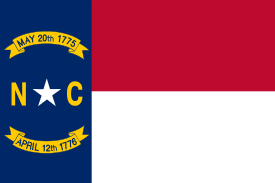 | |
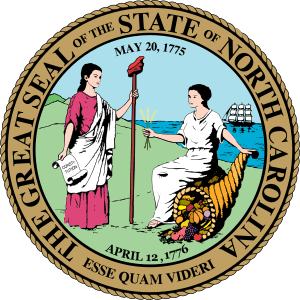 | |
| Living insignia | |
| Bird | Cardinal |
| Butterfly | Eastern tiger swallowtail |
| Fish | Red drum |
| Flower | Flowering dogwood |
| Insect | Western honey bee |
| Mammal | Eastern gray squirrel |
| Marsupial | Virginia opossum |
| Reptile | Eastern box turtle |
| Tree | Pine |
| Inanimate insignia | |
| Beverage | Milk |
| Colors | Red and blue |
| Dance | Clogging |
| Food | Scuppernong grape and sweet potato |
| Fossil | Megalodon teeth |
| Gemstone | Emerald |
| Mineral | Gold |
| Motto | Esse quam videri ("To be, rather than to seem")[1] |
| Rock | Granite |
| Shell | Scotch bonnet |
| Slogan | First Flight (unofficial) |
| Song | "The Old North State" |
| Other | Frog: Pine Barrens tree frog |
| State route marker | |
 | |
| State quarter | |
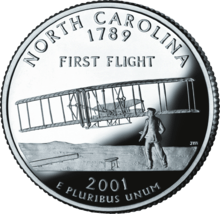 Released in 2001 | |
| Lists of United States state symbols | |
North Carolina was established as a royal colony in 1729 and is one of the original Thirteen Colonies. North Carolina is named in honor of King Charles I of England who first formed the English colony, with Carolus being Latin for "Charles". On November 21, 1789, North Carolina became the 12th state to ratify the United States Constitution. In the run-up to the American Civil War, North Carolina declared its secession from the Union on May 20, 1861, becoming the last of eleven states to join the Confederate States. Following the Civil War, the state was restored to the Union on June 25, 1868.[9] On December 17, 1903, Orville and Wilbur Wright successfully piloted the world's first controlled, sustained flight of a powered, heavier-than-air aircraft at Kill Devil Hills in North Carolina's Outer Banks. North Carolina uses the slogan "First in Flight" on state license plates to commemorate this achievement, alongside a newer alternative design bearing the slogan "First in Freedom" in reference to the Mecklenburg Declaration.
North Carolina is defined by a wide range of elevations and landscapes. From west to east, North Carolina's elevation descends from the Appalachian Mountains to the Piedmont and Atlantic coastal plain. North Carolina's Mount Mitchell at 6,684 feet (2,037 m) is the highest-point in North America east of the Mississippi River.[10] Most of the state falls in the humid subtropical climate zone; however, the western, mountainous part of the state has a subtropical highland climate.
History
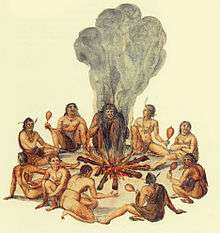
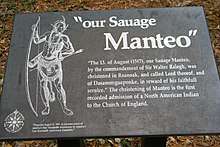
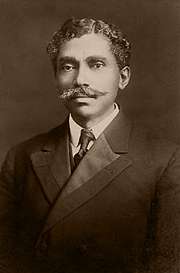
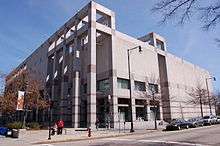
Woodland-culture Native Americans were in the area around 1000 BCE; starting around 750 CE, Mississippian-culture Indians created larger political units with stronger leadership and more stable, longer-term settlements. During this time, important buildings were constructed as pyramidal, flat-topped buildings. By 1550, many groups of American Indians lived in present-day North Carolina, including Chowanoke, Roanoke, Pamlico, Machapunga, Coree, Cape Fear Indians, Waxhaw, Waccamaw, and Catawba.[11]
Juan Pardo explored the area in 1566–1567, establishing Fort San Juan in 1567 at the site of the Native American community of Joara, a Mississippian culture regional chiefdom in the western interior, near the present-day city of Morganton. The fort lasted only 18 months; the local inhabitants killed all but one of the 120 men Pardo had stationed at a total of six forts in the area.[12] A later expedition by Philip Amadas and Arthur Barlowe followed in 1584, at the direction of Sir Walter Raleigh.[11]
In June 1718, the pirate Blackbeard ran his flagship, the Queen Anne's Revenge, aground at Beaufort Inlet, North Carolina, in present-day Carteret County. After the grounding her crew and supplies were transferred to smaller ships. In November, after appealing to the governor of North Carolina, who promised safe-haven and a pardon, Blackbeard was killed in an ambush by troops from Virginia.[13] In 1996 Intersal, Inc., a private firm, discovered the remains of a vessel likely to be the Queen Anne's Revenge, which was added to the U.S. National Register of Historic Places.[14]
North Carolina became one of the English Thirteen Colonies and with the territory of South Carolina was originally known as the Province of North-Carolina. The northern and southern parts of the original province separated in 1729. Originally settled by small farmers, sometimes having a few slaves, who were oriented toward subsistence agriculture, the colony lacked cities or towns. Pirates menaced the coastal settlements, but by 1718 the pirates had been captured and killed. Growth was strong in the middle of the 18th century, as the economy attracted Scots-Irish, Quaker, English and German immigrants. A majority of the colonists generally supported the American Revolution, and a smaller number of Loyalists than in some other colonies such as Georgia, South Carolina, Delaware, New York.
During colonial times, Edenton served as the state capital beginning in 1722, and New Bern was selected as the capital in 1766. Construction of Tryon Palace, which served as the residence and offices of the provincial governor William Tryon, began in 1767 and was completed in 1771. In 1788 Raleigh was chosen as the site of the new capital, as its central location protected it from coastal attacks. Officially established in 1792 as both county seat and state capital, the city was named after Sir Walter Raleigh, sponsor of Roanoke, the "lost colony" on Roanoke Island.[15] The population of the colony more than quadrupled from 52,000 in 1740 to 270,000 in 1780 from high immigration from Virginia, Maryland and Pennsylvania plus immigrants from abroad.[16]
North Carolina made the smallest per-capita contribution to the Revolutionary War of any state, as only 7,800 men joined the Continental Army under General George Washington; an additional 10,000 served in local militia units under such leaders as General Nathanael Greene.[17] There was some military action, especially in 1780–81. Many Carolinian frontiersmen had moved west over the mountains, into the Washington District (later known as Tennessee), but in 1789, following the Revolution, the state was persuaded to relinquish its claim to the western lands. It ceded them to the national government so the Northwest Territory could be organized and managed nationally.
After 1800, cotton and tobacco became important export crops. The eastern half of the state, especially the Tidewater region, developed a slave society based on a plantation system and slave labor. Many free people of color migrated to the frontier along with their European-American neighbors, where the social system was looser. By 1810, nearly three percent of the free population consisted of free people of color, who numbered slightly more than ten thousand. The western areas were dominated by white families, especially Scots-Irish, who operated small subsistence farms. In the early national period, the state became a center of Jeffersonian and Jacksonian democracy, with a strong Whig presence, especially in the West. After Nat Turner's slave uprising in 1831, North Carolina and other southern states reduced the rights of free blacks. In 1835, the legislature withdrew their right to vote.
On May 20, 1861, North Carolina was the last of the Confederate states to declare secession from the Union, 13 days after the Tennessee legislature voted for secession. Some 125,000 North Carolinians served in the military; 20,000 were killed in battle, the most of any state in the Confederacy, and 21,000 died of disease. The state government was reluctant to support the demands of the national government in Richmond, and the state was the scene of only small battles. In 1865, Durham County saw the largest single surrender of Confederate soldiers when Joseph E. Johnston surrendered the Army of Tennessee and all remaining Confederate forces still active in North Carolina, South Carolina, Georgia, and Florida, totalling 89,270 soldiers.
With the defeat of the Confederacy in 1865, the Reconstruction Era began. The United States abolished slavery without compensation to slaveholders or reparations to freedmen. A Republican Party coalition of black freedmen, northern carpetbaggers and local scalawags controlled state government for three years. The white conservative Democrats regained control of the state legislature in 1870, in part by Ku Klux Klan violence and terrorism at the polls, to suppress black voting. Republicans were elected to the governorship until 1876, when the Red Shirts, a paramilitary organization that arose in 1874 and was allied with the Democratic Party, helped suppress black voting. More than 150 black Americans were murdered in electoral violence in 1876.
Post civil war-debt cycles pushed people to switch from subsistence agriculture to commodity agriculture. Among this time the notorious Crop-Lien system developed and was financially difficult on landless whites and blacks, due to high amounts of usury. Also due to the push for commodity agriculture, the free range was ended. Prior to this time people fenced in their crops and had their livestock feeding on the free range areas. After the ending of the free range people now fenced their animals and had their crops in the open.
Democrats were elected to the legislature and governor's office, but the Populists attracted voters displeased with them. In 1896 a biracial, Populist-Republican Fusionist coalition gained the governor's office and passed laws that would extend the voting franchise to blacks and poor whites. The Democrats regained control of the legislature in 1896 and passed laws to impose Jim Crow and racial segregation of public facilities. Voters of North Carolina's 2nd congressional district elected a total of four African-American congressmen through these years of the late 19th century.
Political tensions ran so high that a small group of white Democrats in 1898 planned to take over the Wilmington government if their candidates were not elected. In the Wilmington Insurrection of 1898, more than 1,500 white men attacked the black newspaper and neighborhood, killed numerous men, and ran off the white Republican mayor and aldermen. They installed their own people and elected Alfred M. Waddell as mayor, in the only coup d'état in United States history.[18]
In 1899 the state legislature passed a new constitution, with requirements for poll taxes and literacy tests for voter registration which disenfranchised most black Americans in the state.[19] Exclusion from voting had wide effects: it meant black Americans could not serve on juries or in any local office. After a decade of white supremacy, many people forgot that North Carolina had ever had thriving middle-class black Americans.[20] Black citizens had no political voice in the state until after the federal Civil Rights Act of 1964 and Voting Rights Act of 1965 were passed to enforce their constitutional rights. It was not until 1992 that another African American was elected as a U.S. Representative from North Carolina.
As in the rest of the former Confederacy, North Carolina had become a one-party state, dominated by the Democratic Party. Impoverished by the Civil War and vicious debt cycles, the state continued with an economy based on tobacco, cotton textiles and commodity agriculture. Towns and cities remained few in the east. A major industrial base emerged in the late 19th century in the counties of the Piedmont Triad, based on cotton mills established at the fall line. Railroads were built to connect the new industrializing cities. The state was the site of the first successful controlled, powered and sustained heavier-than-air flight, by the Wright brothers, near Kitty Hawk on December 17, 1903. In the first half of the 20th century, many African Americans left the state to go North for better opportunities, in the Great Migration. Their departure changed the demographic characteristics of many areas.
North Carolina was hard hit by the Great Depression, but the New Deal programs of Franklin D. Roosevelt for cotton and tobacco significantly helped the farmers. After World War II, the state's economy grew rapidly, highlighted by the growth of such cities as Charlotte, Raleigh, and Durham in the Piedmont. Raleigh, Durham, and Chapel Hill form the Research Triangle, a major area of universities and advanced scientific and technical research. In the 1990s, Charlotte became a major regional and national banking center. Tourism has also been a boon for the North Carolina economy as people flock to the Outer Banks coastal area and the Appalachian Mountains anchored by Asheville.
By the 1970s, spurred in part by the increasingly leftward tilt of national Democrats, conservative whites began to vote for Republican national candidates and gradually for more Republicans locally. The Greensboro Sit-ins played a crucial role in the Civil Rights Movement to bring full equality to American blacks.
Native Americans, lost colonies, and permanent settlement
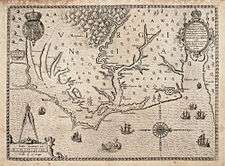
North Carolina was inhabited for at least ten thousand years by succeeding prehistoric indigenous cultures. The Hardaway Site saw major periods of occupation as far back as 10,000 years. Before 200 AD, they were building earthwork mounds, which were used for ceremonial and religious purposes. Succeeding peoples, including those of the ancient Mississippian culture established by 1000 AD in the Piedmont, continued to build or add on to such mounds. In the 500–700 years preceding European contact, the Mississippian culture built large, complex cities and maintained far-flung regional trading networks. Its largest city was Cahokia, located in present-day Illinois near the Mississippi River.
Historically documented tribes in the North Carolina region include the Carolina Algonquian-speaking tribes of the coastal areas, such as the Chowanoke, Roanoke, Pamlico, Machapunga, Coree, and Cape Fear Indians, who were the first encountered by the English; the Iroquoian-speaking Meherrin, Cherokee, and Tuscarora of the interior; and Southeastern Siouan tribes, such as the Cheraw, Waxhaw, Saponi, Waccamaw, and Catawba.
Spanish explorers traveling inland in the 16th century met Mississippian culture people at Joara, a regional chiefdom near present-day Morganton. Records of Hernando de Soto attested to his meeting with them in 1540. In 1567 Captain Juan Pardo led an expedition to claim the area for the Spanish colony and to establish another route to protect silver mines in Mexico. Pardo made a winter base at Joara, which he renamed Cuenca. His expedition built Fort San Juan and left a contingent of 30 men there, while Pardo traveled further, and built and garrisoned five other forts. He returned by a different route to Santa Elena on Parris Island, South Carolina, then a center of Spanish Florida. In the spring of 1568, natives killed all but one of the soldiers and burned the six forts in the interior, including the one at Fort San Juan. Although the Spanish never returned to the interior, this effort marked the first European attempt at colonization of the interior of what became the United States. A 16th-century journal by Pardo's scribe Bandera and archaeological findings since 1986 at Joara have confirmed the settlement.[12][21]
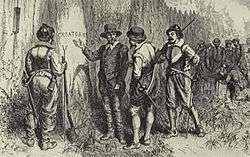
In 1584, Elizabeth I granted a charter to Sir Walter Raleigh, for whom the state capital is named, for land in present-day North Carolina (then part of the territory of Virginia).[22] It was the second American territory which the English attempted to colonize. Raleigh established two colonies on the coast in the late 1580s, but both failed. The fate of the "Lost Colony" of Roanoke Island remains one of the most widely debated mysteries of American history. Virginia Dare, the first English child to be born in North America, was born on Roanoke Island on August 18, 1587; Dare County is named for her.
As early as 1650, settlers from the Virginia colony moved into the area of Albemarle Sound. By 1663, King Charles II of England granted a charter to start a new colony on the North American continent; it generally established North Carolina's borders. He named it Carolina in honor of his father Charles I.[23] By 1665, a second charter was issued to attempt to resolve territorial questions. In 1710, owing to disputes over governance, the Carolina colony began to split into North Carolina and South Carolina. The latter became a crown colony in 1729.
In the 1700s, a series of smallpox epidemics swept the South, causing high fatalities among the Native Americans, who had no immunity to the new disease (it had become endemic in Europe).[24] According to the historian Russell Thornton, "The 1738 epidemic was said to have killed one-half of the Cherokee, with other tribes of the area suffering equally."[25]
Colonial period and Revolutionary War
After the Spanish in the 16th century, the first permanent European settlers of North Carolina were English colonists who migrated south from Virginia. The latter had grown rapidly and land was less available. Nathaniel Batts was documented as one of the first of these Virginian migrants. He settled south of the Chowan River and east of the Great Dismal Swamp in 1655.[26] By 1663, this northeastern area of the Province of Carolina, known as the Albemarle Settlements, was undergoing full-scale English settlement.[27] During the same period, the English monarch Charles II gave the province to the Lords Proprietors, a group of noblemen who had helped restore Charles to the throne in 1660. The new province of "Carolina" was named in honor and memory of King Charles I (Latin: Carolus). In 1712, North Carolina became a separate colony. Except for the Earl Granville holdings, it became a royal colony seventeen years later.[28] A large revolt happened in the state in 1711 known as Cary's Rebellion.
Differences in the settlement patterns of eastern and western North Carolina, or the Low Country and uplands, affected the political, economic, and social life of the state from the 18th until the 20th century. The Tidewater in eastern North Carolina was settled chiefly by immigrants from rural England and the Scottish Highlands. The upcountry of western North Carolina was settled chiefly by Scots-Irish, English, and German Protestants, the so-called "cohee". Arriving during the mid- to late 18th century, the Scots-Irish from what is today Northern Ireland were the largest non-English immigrant group before the Revolution; English indentured servants were overwhelmingly the largest immigrant group before the Revolution.[29][30][31][30][31][32] During the American Revolutionary War, the English and Highland Scots of eastern North Carolina tended to remain loyal to the British Crown, because of longstanding business and personal connections with Great Britain. The English, Welsh, Scots-Irish, and German settlers of western North Carolina tended to favor American independence from Britain.
Most of the English colonists had arrived as indentured servants, hiring themselves out as laborers for a fixed period to pay for their passage. In the early years the line between indentured servants and African slaves or laborers was fluid. Some Africans were allowed to earn their freedom before slavery became a lifelong status. Most of the free colored families formed in North Carolina before the Revolution were descended from unions or marriages between free white women and enslaved or free African or African-American men. Because the mothers were free, their children were born free. Many had migrated or were descendants of migrants from colonial Virginia.[33] As the flow of indentured laborers to the colony decreased with improving economic conditions in Great Britain, planters imported more slaves, and the state's legal delineations between free and slave status tightened, effectively hardening the latter into a racial caste. The economy's growth and prosperity was based on slave labor, devoted primarily to the production of tobacco.
On April 12, 1776, the colony became the first to instruct its delegates to the Continental Congress to vote for independence from the British Crown, through the Halifax Resolves passed by the North Carolina Provincial Congress. The date of this event is memorialized on the state flag and state seal. Throughout the Revolutionary War, fierce guerrilla warfare erupted between bands of pro-independence and pro-British colonists. In some cases the war was also an excuse to settle private grudges and rivalries. A major American victory in the war took place at King's Mountain along the North Carolina–South Carolina border; on October 7, 1780, a force of 1000 mountain men from western North Carolina (including what is today the state of Tennessee) and southwest Virginia overwhelmed a force of some 1000 British troops led by Major Patrick Ferguson. Most of the soldiers fighting for the British side in this battle were Carolinians who had remained loyal to the Crown (they were called "Tories" or Loyalists). The American victory at Kings Mountain gave the advantage to colonists who favored American independence, and it prevented the British Army from recruiting new soldiers from the Tories.
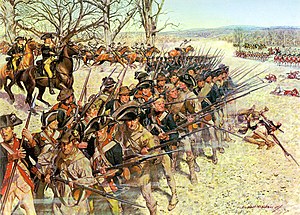
The road to Yorktown and America's independence from Great Britain led through North Carolina. As the British Army moved north from victories in Charleston and Camden, South Carolina, the Southern Division of the Continental Army and local militia prepared to meet them. Following General Daniel Morgan's victory over the British Cavalry Commander Banastre Tarleton at the Battle of Cowpens on January 17, 1781, southern commander Nathanael Greene led British Lord Charles Cornwallis across the heartland of North Carolina, and away from the latter's base of supply in Charleston, South Carolina. This campaign is known as "The Race to the Dan" or "The Race for the River".[28]
In the Battle of Cowan's Ford, Cornwallis met resistance along the banks of the Catawba River at Cowan's Ford on February 1, 1781, in an attempt to engage General Morgan's forces during a tactical withdrawal.[34] Morgan had moved to the northern part of the state to combine with General Greene's newly recruited forces. Generals Greene and Cornwallis finally met at the Battle of Guilford Courthouse in present-day Greensboro on March 15, 1781. Although the British troops held the field at the end of the battle, their casualties at the hands of the numerically superior Continental Army were crippling. Following this "Pyrrhic victory", Cornwallis chose to move to the Virginia coastline to get reinforcements, and to allow the Royal Navy to protect his battered army. This decision would result in Cornwallis' eventual defeat at Yorktown, Virginia, later in 1781. The Patriots' victory there guaranteed American independence.
Antebellum period
On November 21, 1789, North Carolina became the twelfth state to ratify the Constitution. In 1840, it completed the state capitol building in Raleigh, still standing today. Most of North Carolina's slave owners and large plantations were located in the eastern portion of the state. Although North Carolina's plantation system was smaller and less cohesive than that of Virginia, Georgia, or South Carolina, significant numbers of planters were concentrated in the counties around the port cities of Wilmington and Edenton, as well as suburban planters around the cities of Raleigh, Charlotte, and Durham in the Piedmont. Planters owning large estates wielded significant political and socio-economic power in antebellum North Carolina, which was a slave society. They placed their interests above those of the generally non-slave-holding "yeoman" farmers of western North Carolina. In mid-century, the state's rural and commercial areas were connected by the construction of a 129 mi (208 km) wooden plank road, known as a "farmer's railroad", from Fayetteville in the east to Bethania (northwest of Winston-Salem).[28]
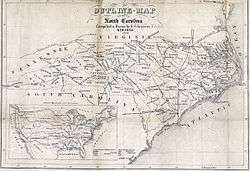
Besides slaves, there were a number of free people of color in the state. Most were descended from free African Americans who had migrated along with neighbors from Virginia during the 18th century. The majority were the descendants of unions in the working classes between white women, indentured servants or free, and African men, indentured, slave or free.[35] After the Revolution, Quakers and Mennonites worked to persuade slaveholders to free their slaves. Some were inspired by their efforts and the language of the Revolution to arrange for manumission of their slaves. The number of free people of color rose markedly in the first couple of decades after the Revolution.[36]
On October 25, 1836, construction began on the Wilmington and Raleigh Railroad[37] to connect the port city of Wilmington with the state capital of Raleigh. In 1849 the North Carolina Railroad was created by act of the legislature to extend that railroad west to Greensboro, High Point, and Charlotte. During the Civil War, the Wilmington-to-Raleigh stretch of the railroad would be vital to the Confederate war effort; supplies shipped into Wilmington would be moved by rail through Raleigh to the Confederate capital of Richmond, Virginia.
During the antebellum period, North Carolina was an overwhelmingly rural state, even by Southern standards. In 1860 only one North Carolina town, the port city of Wilmington, had a population of more than 10,000. Raleigh, the state capital, had barely more than 5,000 residents.
While slaveholding was slightly less concentrated than in some Southern states, according to the 1860 census, more than 330,000 people, or 33% of the population of 992,622, were enslaved African Americans.[38] They lived and worked chiefly on plantations in the eastern Tidewater. In addition, 30,463 free people of color lived in the state.[38] They were also concentrated in the eastern coastal plain, especially at port cities such as Wilmington and New Bern, where a variety of jobs were available. Free African Americans were allowed to vote until 1835, when the state revoked their suffrage in restrictions following the slave rebellion of 1831 led by Nat Turner. Southern slave codes criminalized willful killing of a slave in most cases.[39]
American Civil War
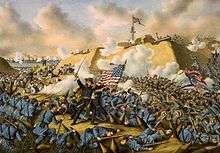
North Carolina was known as a 'Slave State' by 1860, in which one-third of the population was enslaved. This was a smaller proportion than in many other Southern states. The state did not vote to join the Confederacy until President Abraham Lincoln called on it to invade its sister state, South Carolina, becoming the last or penultimate state to officially join the Confederacy. The title of "last to join the Confederacy" has been disputed; although Tennessee's informal secession on May 7, 1861, preceded North Carolina's official secession on May 20,[40][41] the Tennessee legislature did not formally vote to secede until June 8, 1861.[42]
Despite the State supplying the Confederacy with at least 125,000 troops and Union with approximately 15,000 troops, it saw little action on its territory. The supply of Confederate troops was by far the greatest number of any of the Confederate States, of which approximately 40,000 of those died: more than half from disease, the remainder from battlefield wounds and starvation.[43] Elected in 1862, Governor Zebulon Baird Vance tried to maintain state autonomy against Confederate President Jefferson Davis in Richmond.
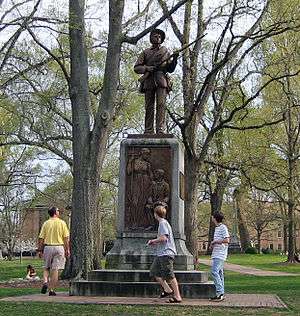
After secession, some North Carolinians refused to support the Confederacy. Some of the yeoman farmers in the state's mountains and western Piedmont region remained neutral during the Civil War, while some covertly supported the Union cause during the conflict. Approximately 2,000 North Carolinians from western North Carolina enlisted in the Union Army and fought for the North in the war. Two additional Union Army regiments were raised in the coastal areas of the state, which were occupied by Union forces in 1862 and 1863. Numerous slaves escaped to Union lines, where they became essentially free.
Confederate troops from all parts of North Carolina served in virtually all the major battles of the Army of Northern Virginia, the Confederacy's most famous army. The largest battle fought in North Carolina was at Bentonville, which was a futile attempt by Confederate General Joseph Johnston to slow Union General William Tecumseh Sherman's advance through the Carolinas in the spring of 1865.[28] In April 1865, after losing the Battle of Morrisville, Johnston surrendered to Sherman at Bennett Place, in what is today Durham. North Carolina's port city of Wilmington was the last Confederate port to fall to the Union, in February 1865, after the Union won the nearby Second Battle of Fort Fisher, its major defense downriver.
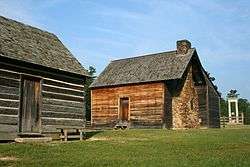
The first Confederate soldier to be killed in the Civil War was Private Henry Wyatt from North Carolina, in the Battle of Big Bethel in June 1861. At the Battle of Gettysburg in July 1863, the 26th North Carolina Regiment participated in Pickett/Pettigrew's Charge and advanced the farthest into the Northern lines of any Confederate regiment. During the Battle of Chickamauga, the 58th North Carolina Regiment advanced farther than any other regiment on Snodgrass Hill to push back the remaining Union forces from the battlefield. At Appomattox Court House in Virginia in April 1865, the 75th North Carolina Regiment, a cavalry unit, fired the last shots of the Confederate Army of Northern Virginia in the Civil War. For many years, North Carolinians proudly boasted that they had been "First at Bethel, Farthest at Gettysburg and Chickamauga, and Last at Appomattox".
Reconstruction
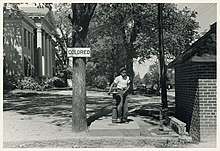
Following the collapse of the Confederacy in 1865, North Carolina, along with the rest of the former Confederate States, was put under direct control by the U.S. military and was relieved of its constitutional government and representation within the United States Congress in what is now referred to as the Reconstruction era. In order to earn back its rights, the state had to make concessions to Washington, one of which was the ratification of the Thirteenth Amendment that was followed through by the North Carolina Supreme Court on December 4, 1865. Congressional Republicans during the Reconstruction, commonly referred to as "radical Republicans", constantly pushed for new constitutions for each of the Southern states that emphasized on equal rights for African-Americans. In 1868, a constitutional convention restored the state government of North Carolina. Though the Fifteenth Amendment was also adopted that same year, it remained in most cases ineffective for almost a century—not to mention paramilitary groups and their lynching with impunity.
The elections in April 1868 following the constitutional convention led to a narrow victory for a Republican-dominated government, with 19 African-Americans holding positions in the North Carolina State Legislature. In attempt to put the reforms into effect, the new Republican Governor William W. Holden declared martial law on any county allegedly not complying with law and order using the passage of the Shoffner Act.
Geography
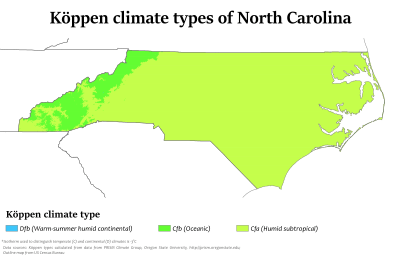
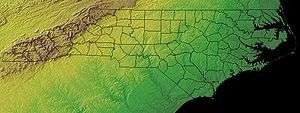
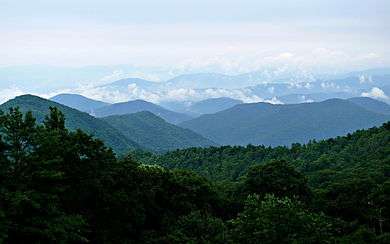
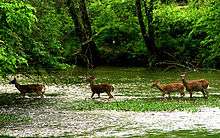
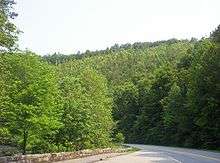
North Carolina is bordered by South Carolina on the south, Georgia on the southwest, Tennessee on the west, Virginia on the north, and the Atlantic Ocean on the east. The United States Census Bureau places North Carolina in the South Atlantic division of the southern region.[44]
North Carolina consists of three main geographic regions: the Atlantic coastal plain, occupying the eastern portion of the state; the central Piedmont region, and the Mountain region in the west, which is part of the Appalachian Mountains. The coastal plain consists of more specifically-defined areas known as the Outer Banks, a string of sandy, narrow barrier islands separated from the mainland by sounds or inlets, including Albemarle Sound and Pamlico Sound, the tidewater region, the native home of the venus flytrap, and the inner coastal plain, where longleaf pine trees are native.
So many ships have been lost off Cape Hatteras that the area is known as the "Graveyard of the Atlantic"; more than a thousand ships have sunk in these waters since records began in 1526. The most famous of these is the Queen Anne's Revenge (flagship of the pirate Blackbeard), which went aground in Beaufort Inlet in 1718.[45]
The coastal plain transitions to the Piedmont region along the Atlantic Seaboard fall line, the elevation at which waterfalls first appear on streams and rivers. The Piedmont region of central North Carolina is the state's most populous region, containing the six largest cities in the state by population.[46] It consists of gently rolling countryside frequently broken by hills or low mountain ridges. Small, isolated, and deeply eroded mountain ranges and peaks are located in the Piedmont, including the Sauratown Mountains, Pilot Mountain, the Uwharrie Mountains, Crowder's Mountain, King's Pinnacle, the Brushy Mountains, and the South Mountains. The Piedmont ranges from about 300 feet (91 m) in elevation in the east to about 1,500 feet (460 m) in the west.
The western section of the state is part of the Appalachian Mountain range. Among the subranges of the Appalachian Mountains located in the state are the Great Smoky Mountains, Blue Ridge Mountains, and Black Mountains.[47][48] The Black Mountains are the highest in the eastern United States, and culminate in Mount Mitchell at 6,684 feet (2,037 m), the highest point east of the Mississippi River.[48][49]
North Carolina has 17 major river basins. The five basins west of the Blue Ridge Mountains flow to the Gulf of Mexico, while the remainder flow to the Atlantic Ocean.[50] Of the 17 basins, 11 originate within the state of North Carolina, but only four are contained entirely within the state's border—the Cape Fear, the Neuse, the White Oak, and the Tar–Pamlico basin.[51]
Flora and fauna
Climate


Elevation above sea level is most responsible for temperature change across the state, with the mountain area being coolest year-round. The climate is also influenced by the Atlantic Ocean and the Gulf Stream, especially in the coastal plain. These influences tend to cause warmer winter temperatures along the coast, where temperatures only occasionally drop below the freezing point at night. The coastal plain averages around 1 inch (2.5 cm) of snow or ice annually, and in many years, there may be no snow or ice at all.[52]
The Atlantic Ocean exerts less influence on the climate of the Piedmont region, which has hotter summers and colder winters than along the coast, though the average daily maximum is still below 90 °F (32 °C) in most locations.[52]
North Carolina experiences severe weather both in summer and in winter, with summer bringing threat of hurricanes, tropical storms, heavy rain, and flooding.[53] Destructive hurricanes that have hit North Carolina include Hurricane Fran, Hurricane Florence, Hurricane Floyd, Hurricane Hugo, and Hurricane Hazel, the latter being the strongest storm ever to make landfall in the state, as a Category 4 in 1954. Hurricane Isabel ranks as the most destructive of the 21st century.[54][55]
North Carolina averages fewer than 20 tornadoes per year, many of them produced by hurricanes or tropical storms along the coastal plain. Tornadoes from thunderstorms are a risk, especially in the eastern part of the state. Western Piedmont is often protected by the mountains, which tend to break up storms as they try to cross over; the storms will often re-form farther east. A phenomenon known as "cold-air damming" often occurs in the northwestern part of the state, which can weaken storms but can also lead to major ice events in winter.[56]
In April 2011, the worst tornado outbreak in North Carolina's history occurred. Thirty confirmed tornadoes touched down, mainly in the Eastern Piedmont and Sandhills, killing at least 24 people.[57][58] In September 2019 Hurricane Dorian hit the area.
| Monthly normal high and low temperatures (Fahrenheit) for various North Carolina cities. | ||||||||||||
| City | Jan | Feb | Mar | Apr | May | Jun | Jul | Aug | Sep | Oct | Nov | Dec |
|---|---|---|---|---|---|---|---|---|---|---|---|---|
| Asheville[59] | 47/27 | 51/30 | 59/35 | 68/43 | 75/51 | 81/60 | 84/64 | 83/63 | 77/56 | 68/45 | 59/36 | 49/29 |
| Boone[60] | 42/21 | 45/23 | 52/29 | 61/37 | 69/46 | 76/54 | 79/58 | 78/57 | 72/50 | 63/39 | 54/31 | 45/24 |
| Cape Hatteras[61] | 52/39 | 54/40 | 59/45 | 66/53 | 74/61 | 81/69 | 85/74 | 84/73 | 80/69 | 72/60 | 64/51 | 56/43 |
| Charlotte[59] | 51/30 | 55/33 | 63/39 | 72/47 | 79/56 | 86/64 | 89/68 | 88/67 | 81/60 | 72/49 | 62/39 | 53/32 |
| Fayetteville[62] | 54/33 | 59/35 | 66/42 | 75/50 | 82/59 | 89/68 | 91/72 | 90/70 | 84/64 | 75/52 | 67/43 | 56/35 |
| Greensboro[62] | 48/30 | 53/32 | 61/39 | 70/47 | 78/56 | 85/65 | 88/69 | 86/68 | 80/61 | 70/49 | 61/40 | 51/32 |
| Raleigh[62] | 51/31 | 55/34 | 63/40 | 72/48 | 80/57 | 87/66 | 90/70 | 88/69 | 82/62 | 73/50 | 64/41 | 54/33 |
| Wilmington[63] | 56/36 | 60/38 | 66/44 | 74/52 | 81/60 | 87/69 | 90/73 | 88/71 | 84/66 | 76/55 | 68/45 | 59/38 |
| Climate data for North Carolina | |||||||||||||
|---|---|---|---|---|---|---|---|---|---|---|---|---|---|
| Month | Jan | Feb | Mar | Apr | May | Jun | Jul | Aug | Sep | Oct | Nov | Dec | Year |
| Record high °F (°C) | 86 (30) |
90 (32) |
100 (38) |
102 (39) |
107 (42) |
108 (42) |
109 (43) |
110 (43) |
109 (43) |
102 (39) |
90 (32) |
87 (31) |
110 (43) |
| Average high °F (°C) | 49.9 (9.9) |
53.7 (12.1) |
61.8 (16.6) |
71.0 (21.7) |
78.1 (25.6) |
85.2 (29.6) |
88.1 (31.2) |
86.8 (30.4) |
80.8 (27.1) |
71.6 (22.0) |
62.5 (16.9) |
52.5 (11.4) |
70.2 (21.2) |
| Daily mean °F (°C) | 39.2 (4.0) |
42.3 (5.7) |
49.5 (9.7) |
58.1 (14.5) |
66.1 (18.9) |
74.1 (23.4) |
77.5 (25.3) |
76.3 (24.6) |
69.9 (21.1) |
59.4 (15.2) |
50.4 (10.2) |
41.7 (5.4) |
58.7 (14.8) |
| Average low °F (°C) | 28.4 (−2.0) |
30.9 (−0.6) |
37.2 (2.9) |
45.2 (7.3) |
54.0 (12.2) |
63.0 (17.2) |
66.8 (19.3) |
65.8 (18.8) |
58.9 (14.9) |
47.2 (8.4) |
38.3 (3.5) |
30.8 (−0.7) |
47.2 (8.4) |
| Record low °F (°C) | −34 (−37) |
−20 (−29) |
−12 (−24) |
0 (−18) |
17 (−8) |
23 (−5) |
32 (0) |
31 (−1) |
23 (−5) |
8 (−13) |
−19 (−28) |
−21 (−29) |
−34 (−37) |
| Average precipitation inches (mm) | 3.7 (94) |
3.5 (89) |
4.2 (110) |
3.5 (89) |
3.8 (97) |
4.3 (110) |
4.8 (120) |
4.7 (120) |
4.3 (110) |
3.3 (84) |
3.3 (84) |
3.5 (89) |
46.9 (1,196) |
| Average snowfall inches (cm) | 2.0 (5.1) |
1.4 (3.6) |
0.6 (1.5) |
0.1 (0.25) |
0.0 (0.0) |
0.0 (0.0) |
0.0 (0.0) |
0.0 (0.0) |
0.0 (0.0) |
0.0 (0.0) |
0.1 (0.25) |
0.8 (2.0) |
5 (12.7) |
| Source 1: "North Carolina Climate Data according USA.com". (averages) | |||||||||||||
| Source 2: "North Carolina Climate Office". (extremes) | |||||||||||||
Demographics
| Historical population | |||
|---|---|---|---|
| Census | Pop. | %± | |
| 1790 | 393,751 | — | |
| 1800 | 478,103 | 21.4% | |
| 1810 | 556,526 | 16.4% | |
| 1820 | 638,829 | 14.8% | |
| 1830 | 737,987 | 15.5% | |
| 1840 | 753,419 | 2.1% | |
| 1850 | 869,039 | 15.3% | |
| 1860 | 992,622 | 14.2% | |
| 1870 | 1,071,361 | 7.9% | |
| 1880 | 1,399,750 | 30.7% | |
| 1890 | 1,617,949 | 15.6% | |
| 1900 | 1,893,810 | 17.1% | |
| 1910 | 2,206,287 | 16.5% | |
| 1920 | 2,559,123 | 16.0% | |
| 1930 | 3,170,276 | 23.9% | |
| 1940 | 3,571,623 | 12.7% | |
| 1950 | 4,061,929 | 13.7% | |
| 1960 | 4,556,155 | 12.2% | |
| 1970 | 5,082,059 | 11.5% | |
| 1980 | 5,881,766 | 15.7% | |
| 1990 | 6,628,637 | 12.7% | |
| 2000 | 8,049,313 | 21.4% | |
| 2010 | 9,535,483 | 18.5% | |
| Est. 2019 | 10,488,084 | 10.0% | |
| Source: 1910–2010[64] 2019 estimate[65] | |||
The United States Census Bureau estimates that the population of North Carolina was 10,488,084 on July 1, 2019, an 9.99% increase since the 2010 Census.[65] Of the people residing in North Carolina 58.5% were born there; 33.1% were born in another state; 1.0% were born in Puerto Rico, U.S. Island areas, or born abroad to American parent(s); and 7.4% were foreign-born.[66]
Ethnicity
Demographics of North Carolina covers the variety of ethnic groups who reside in North Carolina, along with the relevant trends.
The state's racial composition in the 2010 Census:[67]
- White: 68.5% (65.3% non-Hispanic white, 3.2% White Hispanic)
- Black or African American: 21.5%
- Latin and Hispanic American of any race: 8.4%
- Some other race: 4.3%
- Multiracial American: 2.2%
- Asian American: 2.2%
- Native Hawaiian and Pacific Islander: 1%
| Racial composition | 1990[68] | 2000[69] | 2010[70] |
|---|---|---|---|
| White | 75.6% | 72.1% | 68.5% |
| Black | 22.0% | 21.6% | 21.4% |
| Asian | 0.8% | 1.4% | 2.2% |
| Native | 1.2% | 1.2% | 1.3% |
| Native Hawaiian and other Pacific Islander | – | 0.1% | 0.1% |
| Other race | 0.5% | 2.3% | 4.3% |
| Two or more races | – | 1.3% | 2.3% |
Languages
As of 2010, 89.66% (7,750,904) of North Carolina residents age five and older spoke English at home as a primary language, while 6.93% (598,756) spoke Spanish, 0.32% (27,310) French, 0.27% (23,204) German, and Chinese (which includes Mandarin) was spoken as a main language by 0.27% (23,072) of the population five and older. In total, 10.34% (893,735) of North Carolina's population age five and older spoke a mother language other than English.[71] North Carolina is also home to a spectrum of different dialects of Southern American English and Appalachian English.
| Language | Percentage of population (as of 2010)[71] |
|---|---|
| Spanish | 6.93% |
| French | 0.32% |
| German | 0.27% |
| Chinese (including Mandarin) | 0.27% |
| Vietnamese | 0.24% |
| Arabic | 0.17% |
| Korean | 0.16% |
| Tagalog | 0.13% |
| Hindi | 0.12% |
| Gujarati, Russian, and Hmong (tied) | 0.11% |
| Italian and Japanese (tied) | 0.08% |
| Cherokee | 0.01%[72] |
Religion
North Carolina residents, like those of other Southern states, since the colonial era have historically been overwhelmingly Protestant, first Anglican, then Baptist and Methodist. Before the Civil War, the Baptists split into regional associations of the North and South, over the issue of slavery.
By the late 19th century, the largest Protestant denomination in North Carolina was the Baptist, when both whites and blacks were considered, but the latter people had set up their own organizations. After emancipation, black Baptists quickly set up their own independent congregations in North Carolina and other states of the South, as they wanted to be free of white supervision.[74][75][76] Black Baptists developed their own state and national associations, such as the National Baptist Convention USA, Inc..[75]
While the Baptists in total (counting both blacks and whites) have maintained the majority in this part of the country (known as the Bible Belt), a wide variety of faiths are practiced by other residents in the state, including Judaism, Islam, Baha'i, Buddhism, and Hinduism. As of 2010 the Southern Baptist Convention was the biggest denomination, with 4,241 churches and 1,513,000 members; the second largest was the United Methodist Church, with 660,000 members and 1,923 churches. The third was the Roman Catholic Church, with 428,000 members in 190 parishes. The fourth greatest was the Presbyterian Church (USA), with 186,000 members and 710 congregations; this denomination was brought by Scots-Irish immigrants who settled the backcountry in the colonial era.[77]
The state also has a special history with the Moravian Church, as settlers of this faith (largely of German origin) settled in the Winston-Salem area in the 18th and 19th centuries. Presbyterians, historically Scots-Irish, have had a strong presence in Charlotte and in Scotland County.
Currently, the rapid influx of northerners and immigrants from Latin America is steadily increasing ethnic and religious diversity: the number of Roman Catholics and Jews in the state has increased, as well as general religious diversity. The second-largest Protestant denomination in North Carolina after Baptist traditions is Methodism, which is strong in the northern Piedmont, especially in populous Guilford County. There are also a substantial number of Quakers in Guilford County and northeastern North Carolina. Many universities and colleges in the state have been founded on religious traditions, and some currently maintain that affiliation, including:[78]
- Barton College (Disciples of Christ)
- Belmont Abbey College (Catholic)
- Bennett College for Women (United Methodist Church)
- Brevard College (United Methodist Church)
- Campbell University (Baptist)
- Catawba College (United Church of Christ)
- Chowan University (Baptist)
- Davidson College (Presbyterian)
- Duke University (Historically Methodist)
- Elon University (United Church of Christ)
- Gardner–Webb University (Cooperative Baptist Fellowship)
- Greensboro College (Methodist)
- Guilford College (Religious Society of Friends Quakers)
- High Point University (United Methodist Church)
- Lees-McRae College (Presbyterian)
- Lenoir-Rhyne University (Evangelical Lutheran Church in America)
- Livingstone College (African Methodist Episcopal Zion Church)
- Louisburg College (United Methodist Church)
- Mars Hill University (Christian)
- Methodist University (United Methodist Church)
- Montreat College (Christian)
- University of Mount Olive (Baptist)
- North Carolina Wesleyan College (United Methodist Church)
- William Peace University (Presbyterian)
- Pfeiffer University (Methodist)
- Queens University of Charlotte (Presbyterian)
- St. Andrews Presbyterian College (Presbyterian)
- Saint Augustine's College (Episcopal)
- Salem College (Moravian Church)
- Shaw University (Baptist)
- Wake Forest University (Historically Baptist)
- Warren Wilson College (Historically Presbyterian)
- Wingate University (Historically Baptist)
The state also has several major seminaries, including the Southeastern Baptist Theological Seminary in Wake Forest, and the Hood Theological Seminary (AME Zion) in Salisbury.
Most populous counties
In 2016, the U.S. Census Bureau released 2015 population estimate counts for North Carolina's counties. Mecklenburg County has the largest population, while Wake County has the second largest population in North Carolina.[79]
Major cities
In 2018, the U.S. Census Bureau released 2018 population estimate counts for North Carolina's cities with populations above 70,000. Charlotte has the largest population, while Raleigh has the highest population density of North Carolina's largest cities.[80]
Largest combined statistical areas
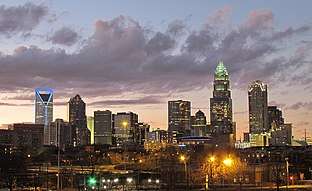
North Carolina has three major Combined Statistical Areas with populations of more than 1.6 million (U.S. Census Bureau 2018 estimates):[82]
- Metrolina: Charlotte–Concord–Gastonia, North Carolina–South Carolina population 2,728,933[82]
- The Research Triangle: Raleigh–Durham–Chapel Hill, North Carolina population 2,238,315[82]
- The Piedmont Triad: Greensboro–Winston-Salem–High Point, North Carolina population 1,677,551[82]
Economy
North Carolina's 2018 total gross state product was $496 billion.[83] Based on American Community Survey 2010–2014 data, North Carolina's median household income was $46,693. It ranked forty-first out of fifty states plus the District of Columbia for median household income. North Carolina had the fourteenth highest poverty rate in the nation at 17.6%. 13% of families were below the poverty line. [84]
The state has a very diverse economy because of its great availability of hydroelectric power, its pleasant climate, and its wide variety of soils. The state ranks third among the South Atlantic states in population, but leads the region in industry and agriculture. North Carolina leads the nation in the production of tobacco,[85] textiles, and furniture. Charlotte, the state's largest city, is a major textile and trade center. According to a Forbes article written in 2013 Employment in the "Old North State" has gained many different industry sectors. Science, technology, engineering, and math (STEM) industries in the area surrounding North Carolina's capital have grown 17.9 percent since 2001, placing Raleigh-Cary at No. 5 among the 51 largest metro areas in the country where technology is booming. In 2010, North Carolina's total gross state product was $424.9 billion,[86] while the state debt in November 2012, according to one source, totalled $2.4 billion,[87] while according to another, was in 2012 $57.8 billion.[88] In 2011, the civilian labor force was at around 4.5million with employment near 4.1 million.
North Carolina is the leading U.S. state in production of flue-cured tobacco and sweet potatoes, and comes second in the farming of pigs and hogs, trout, and turkeys.[89][90] In the three most recent USDA surveys (2002, 2007, 2012), North Carolina also ranked second in the production of Christmas trees.[89][91][92]
North Carolina has 15 metropolitan areas,[93] and in 2010 was chosen as the third-best state for business by Forbes Magazine, and the second-best state by Chief Executive Officer Magazine.[94] Since 2000, there has been a clear division in the economic growth of North Carolina's urban and rural areas. While North Carolina's urban areas have enjoyed a prosperous economy with steady job growth, low unemployment, and rising wages, many of the state's rural counties have suffered from job loss, rising levels of poverty, and population loss as their manufacturing base has declined. According to one estimate, one-half of North Carolina's 100 counties have lost population since 2010, primarily due to the poor economy in many of North Carolina's rural areas. However, the population of the state's urban areas is steadily increasing.[95]
Transportation
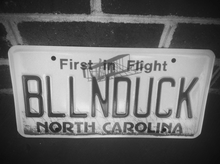
Transportation systems in North Carolina consist of air, water, road, rail, and public transportation including intercity rail via Amtrak and light rail in Charlotte. North Carolina has the second-largest state highway system in the country as well as the largest ferry system on the east coast.[96]
North Carolina's airports serve destinations throughout the United States and international destinations in Canada, Europe, Central America, and the Caribbean. In 2013 Charlotte Douglas International Airport, which serves as the second busiest hub for American Airlines, ranked as the 23rd busiest airport in the world.[97]
North Carolina has a growing passenger rail system with Amtrak serving most major cities. Charlotte is also home to North Carolina's only light rail system known as the Lynx.
Government and politics
| Year | Democratic | Republican |
|---|---|---|
| 1952 | 67.5% 796,306 | 32.5% 383,329 |
| 1956 | 67.0% 760,480 | 33.1% 375,379 |
| 1960 | 54.5% 735,248 | 45.5% 613,975 |
| 1964 | 56.6% 790,343 | 43.4% 606,165 |
| 1968 | 52.7% 821,233 | 47.3% 737,075 |
| 1972 | 48.5% 729,104 | 51.0% 767,470 |
| 1976 | 65.0% 1,081,293 | 33.9% 564,102 |
| 1980 | 61.9% 1,143,145 | 37.4% 691,449 |
| 1984 | 45.4% 1,011,209 | 54.3% 1,208,167 |
| 1988 | 43.9% 957,687 | 56.1% 1,222,338 |
| 1992 | 52.7% 1,368,246 | 43.2% 1,121,955 |
| 1996 | 56.0% 1,436,638 | 42.8% 1,097,053 |
| 2000 | 52.0% 1,530,324 | 46.3% 1,360,960 |
| 2004 | 55.6% 1,939,154 | 42.9% 1,495,021 |
| 2008 | 50.3% 2,146,189 | 46.9% 2,001,168 |
| 2012 | 43.2% 1,931,580 | 54.6% 2,440,707 |
| 2016 | 49.0% 2,309,157 | 48.8% 2,298,880 |
| Year | Democratic | Republican |
|---|---|---|
| 1952 | 53.9% 652,803 | 46.1% 558,107 |
| 1956 | 50.7% 590,530 | 49.3% 575,062 |
| 1960 | 52.1% 713,136 | 47.9% 655,420 |
| 1964 | 56.2% 800,139 | 43.9% 624,844 |
| 1968 | 29.2% 464,113 | 39.5% 627,192 |
| 1972 | 28.9% 438,705 | 69.5% 1,054,889 |
| 1976 | 55.3% 927,365 | 44.2% 741,960 |
| 1980 | 47.2% 875,635 | 49.3% 915,018 |
| 1984 | 37.9% 824,287 | 61.9% 1,346,481 |
| 1988 | 41.7% 890,167 | 58.0% 1,237,258 |
| 1992 | 42.7% 1,114,042 | 43.4% 1,134,661 |
| 1996 | 44.0% 1,107,849 | 48.7% 1,225,938 |
| 2000 | 43.2% 1,257,692 | 56.0% 1,631,163 |
| 2004 | 43.6% 1,525,849 | 56.0% 1,961,166 |
| 2008 | 49.7% 2,142,651 | 49.4% 2,128,474 |
| 2012 | 48.4% 2,178,391 | 50.4% 2,270,395 |
| 2016 | 46.2% 2,189,316 | 49.8% 2,362,631 |
The government of North Carolina is divided into three branches: executive, legislative, and judicial. These consist of the Council of State (led by the Governor), the bicameral legislature (called the General Assembly), and the state court system (headed by the North Carolina Supreme Court). The state constitution delineates the structure and function of the state government. North Carolina has 13 seats in the U.S. House of Representatives and two seats in the U.S. Senate.
North Carolina's party loyalties have undergone a series of important shifts in the last few years: While the 2010 midterms saw Tar Heel voters elect a bicameral Republican majority legislature for the first time in more than a century, North Carolina has also become a Southern swing state in presidential races. Since Southern Democrat Jimmy Carter's comfortable victory in the state in 1976, the state had consistently leaned Republican in presidential elections until Democrat Barack Obama narrowly won the state in 2008. In the 1990s, Democrat Bill Clinton came within a point of winning the state in 1992 and also only narrowly lost the state in 1996. In the early 2000s, Republican George W. Bush easily won the state by more than 12 points.
By 2008, demographic shifts, population growth, and increased liberalization in densely populated areas such as the Research Triangle, Charlotte, Greensboro, Winston-Salem, Fayetteville, and Asheville, propelled Barack Obama to victory in North Carolina, the first Democrat to win the state since 1976. In 2012, North Carolina was again considered a competitive swing state, with the Democrats even holding their 2012 Democratic National Convention in Charlotte. However, Republican Mitt Romney ultimately eked out a two-point win in North Carolina, the only 2012 swing state that Obama lost, and one of only two states (along with Indiana) to flip from Obama in 2008 to the GOP in 2012.
In 2012, the state elected a Republican Governor (Pat McCrory) and Lieutenant Governor (Dan Forest) for the first time in more than two decades, while also giving the Republicans veto-proof majorities in both the State House of Representatives and the State Senate.
| North Carolina registered voters as of July 25, 2020[99] | |||||
|---|---|---|---|---|---|
| Party | Number of Voters | Percentage | |||
| Democratic | 2,535,222 | 36.06% | |||
| Unaffiliated | 2,343,507 | 33.33% | |||
| Republican | 2,104,343 | 29.93% | |||
| Libertarian | 41,136 | 0.59% | |||
| Constitution | 3,640 | 0.05% | |||
| Green | 2,510 | 0.04% | |||
| Total | 7,030,358 | 100% | |||
Because of gerrymandering in redistricting after the 2010 census, Democrats have been underrepresented in the state and Congressional delegations since 2012, although they have sometimes represented more than half the state's population.[100]
Several U.S. House of Representatives seats flipped control in 2012, with the Republicans holding nine seats to the Democrats' four. In the 2014 mid-term elections, Republican David Rouzer won the state's seventh congressional district seat, increasing the congressional delegation party split to 10–3 in favor of the GOP.
The state was sued for racially gerrymandering the districts, which resulted in minority voting power being diluted in some areas, resulting in skewed representation. The federal court ordered redistricting in 2015.[100]
"I propose that we draw the maps to give a partisan advantage to 10 Republicans and three Democrats because I do not believe it's possible to draw a map with 11 Republicans and two Democrats," David Lewis, a Republican state representative who led the redistricting effort, said at the time.[100]
"North Carolina Republicans won 10 of the 13 seats in 2016, when Democrats got 47 percent of the statewide vote. In 2018 Republicans took nine, with one seat undecided, even though Democrats got 48 percent of the overall vote. (Excluding one district where a Republican ran unopposed, Democrats' share in 2018 was 51 percent.)"[100]
(The undecided election in North Carolina's 9th congressional district was because the bipartisan State Election Board refused in February 2019 to certify the results, after an investigation found evidence of widespread ballot fraud committed by Republican operatives.)[101]
Two suits challenging the state congressional district map were led by "two dozen voters, the state Democratic Party, the state chapter of the League of Women Voters, and the interest group Common Cause".[100] They contend that the redistricting resulted in deliberate under-representation of a substantial portion of voters. This case reached the United States Supreme Court in March 2019, which also heard a related partisan gerrymandering case from Maryland.[100]
Education
Primary and secondary education

Elementary and secondary public schools are overseen by the North Carolina Department of Public Instruction. The North Carolina Superintendent of Public Instruction is the secretary of the North Carolina State Board of Education, but the board, rather than the superintendent, holds most of the legal authority for making public education policy. In 2009, the board's chairman also became the "chief executive officer" for the state's school system.[102] North Carolina has 115 public school systems, each of which is overseen by a local school board.[103][104] A county may have one or more systems within it. The largest school systems in North Carolina are the Wake County Public School System, Charlotte-Mecklenburg Schools, Guilford County Schools, Winston-Salem/Forsyth County Schools, and Cumberland County Schools.[105] In total there are 2,425 public schools in the state, including over 200 charter schools.[106] North Carolina Schools were segregated until the Brown v. Board of Education trial and the release of the Pearsall Plan.
Colleges and universities
In 1795, North Carolina opened the first public university in the United States—the University of North Carolina (now named the University of North Carolina at Chapel Hill).[107] More than 200 years later, the University of North Carolina system encompasses 17 public universities including North Carolina State University, North Carolina A&T State University, North Carolina Central University, the University of North Carolina at Chapel Hill, the University of North Carolina at Greensboro, East Carolina University, Western Carolina University, Winston-Salem State University, the University of North Carolina at Asheville, the University of North Carolina at Charlotte, the University of North Carolina at Pembroke, UNC Wilmington, Elizabeth City State University, Appalachian State University, Fayetteville State University, and UNC School of the Arts, and .[108] Along with its public universities, North Carolina has 58 public community colleges in its community college system. The largest university in North Carolina is currently North Carolina State University, with more than 34,000 students.[109]
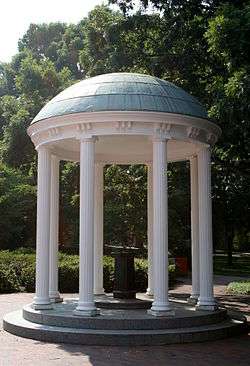
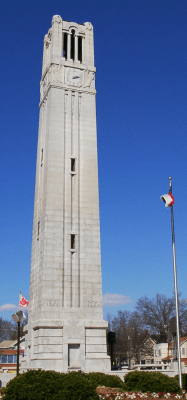
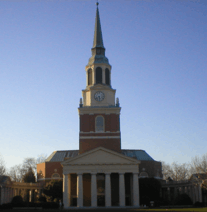
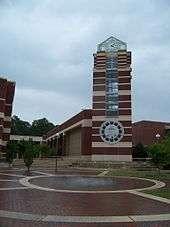
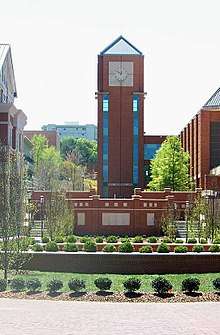
North Carolina is also home to many well-known private colleges and universities, including Duke University,[110] Wake Forest University,[111] Pfeiffer University, Lees-McRae College, Davidson College, Barton College, North Carolina Wesleyan College, Elon University, Guilford College, Livingstone College, Salem College, Shaw University (the first historically black college or university in the South), Laurel University, Meredith College, Methodist University, Belmont Abbey College (the only Catholic college in the Carolinas), Campbell University, University of Mount Olive, Montreat College, High Point University, Lenoir-Rhyne University (the only Lutheran university in North Carolina) and Wingate University.
Media
Early newspapers were established in the eastern part of North Carolina in the mid-18th century. The Fayetteville Observer, established in 1816, is the oldest newspaper still in publication in North Carolina. The Wilmington Star-News, established 1867, is the oldest continuously running newspaper. As of January 1, 2020, there were approximately 240 North Carolina newspapers in publication in the state of North Carolina.[112]
Sports
North Carolina is home to four major league sports franchises: the Carolina Panthers of the National Football League, the Charlotte Hornets of the National Basketball Association, and Charlotte FC of Major League Soccer are based in Charlotte, while the Raleigh-based Carolina Hurricanes play in the National Hockey League. The Panthers and Hurricanes are the only two major professional sports teams that have the same geographical designation while playing in different metropolitan areas. The Hurricanes are the only major professional team from North Carolina to have won a league championship, having captured the Stanley Cup in 2006. North Carolina is also home to two other top-level professional teams in less prominent sports—the Charlotte Hounds of Major League Lacrosse and the North Carolina Courage of the National Women's Soccer League.
While North Carolina has no Major League Baseball team, it does have numerous minor league baseball teams, with the highest level of play coming from the AAA-affiliated Charlotte Knights and Durham Bulls. Additionally, North Carolina has minor league teams in other team sports including soccer and ice hockey, most notably North Carolina FC and the Charlotte Checkers, both of which play in the second tier of their respective sports.
In addition to professional team sports, North Carolina has a strong affiliation with NASCAR and stock-car racing, with Charlotte Motor Speedway in Concord hosting two Cup Series races every year. Charlotte also hosts the NASCAR Hall of Fame, while Concord is the home of several top-flight racing teams, including Hendrick Motorsports, Roush Fenway Racing, Richard Petty Motorsports, Stewart-Haas Racing, and Chip Ganassi Racing. Numerous other tracks around North Carolina host races from low-tier NASCAR circuits as well.
Golf is a popular summertime leisure activity, and North Carolina has hosted several important professional golf tournaments. Pinehurst Resort in Pinehurst has hosted a PGA Championship, Ryder Cup, two U.S. Opens, and one U.S. Women's Open. The Wells Fargo Championship is a regular stop on the PGA Tour and is held at Quail Hollow Club in Charlotte, and Quail Hollow has also played host to the PGA Championship. The Wyndham Championship is played annually in Greensboro at Sedgefield Country Club.
College sports are also popular in North Carolina, with 18 schools competing at the Division I level. The Atlantic Coast Conference (ACC) is headquartered in Greensboro, and both the ACC Football Championship Game (Charlotte) and the ACC Men's Basketball Tournament (Greensboro) were most recently held in North Carolina. Additionally, the city of Charlotte is home to the National Junior College Athletics Association's (NJCAA) headquarters.[113] College basketball is very popular in North Carolina, buoyed by the Tobacco Road rivalries between ACC members North Carolina, Duke, North Carolina State, and Wake Forest. The ACC Championship Game and the Duke's Mayo Bowl are held annually in Charlotte's Bank of America Stadium, featuring teams from the ACC and the Southeastern Conference. Additionally, the state has hosted the NCAA Men's Basketball Final Four on two occasions, in Greensboro in 1974 and in Charlotte in 1994.
Tourism
Charlotte is the most-visited city in the state, attracting 28.3 million visitors in 2018.[114] Area attractions include Carolina Panthers NFL football team and Charlotte Hornets basketball team, Carowinds amusement park, Charlotte Motor Speedway, U.S. National Whitewater Center, Discovery Place, Great Wolf Lodge, Sea Life Aquarium, Bechtler Museum of Modern Art, Billy Graham Library, Carolinas Aviation Museum, Harvey B. Gantt Center for African-American Arts + Culture, Levine Museum of the New South, McColl Center for Art + Innovation, Mint Museum, and the NASCAR Hall of Fame.
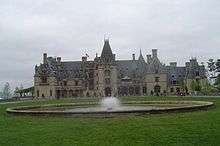
Every year the Appalachian Mountains attract several million tourists to the western part of the state, including the historic Biltmore Estate. The scenic Blue Ridge Parkway and Great Smoky Mountains National Park are the two most visited national park and unit in the United States with more than 25 million visitors in 2013.[115] The City of Asheville is consistently voted as one of the top places to visit and live in the United States, known for its rich art deco architecture, mountain scenery and outdoor activities.[116][117]
In Raleigh, many tourists visit the Capital, African American Cultural Complex, Contemporary Art Museum of Raleigh, Gregg Museum of Art & Design at NCSU, Haywood Hall House & Gardens, Marbles Kids Museum, North Carolina Museum of Art, North Carolina Museum of History, North Carolina Museum of Natural Sciences, North Carolina Sports Hall of Fame, Raleigh City Museum, J. C. Raulston Arboretum, Joel Lane House, Mordecai House, Montfort Hall, and the Pope House Museum. The Carolina Hurricanes NHL hockey team is also located in the city.
In the Conover–Hickory area, Hickory Motor Speedway, RockBarn Golf and Spa, home of the Greater Hickory Classic at Rock Barn; Catawba County Firefighters Museum, and SALT Block attract many tourists to Conover. Hickory which has Valley Hills Mall.
The Piedmont Triad, or center of the state, is home to Krispy Kreme, Mayberry, Texas Pete, the Lexington Barbecue Festival, and Moravian cookies. The internationally acclaimed North Carolina Zoo in Asheboro attracts visitors to its animals, plants, and a 57-piece art collection along five miles of shaded pathways in the world's largest-land-area natural-habitat park. Seagrove, in the central portion of the state, attracts many tourists along Pottery Highway (NC Hwy 705). MerleFest in Wilkesboro attracts more than 80,000 people to its four-day music festival; and Wet 'n Wild Emerald Pointe water park in Greensboro is another attraction.
The Outer Banks and surrounding beaches attract millions of people to the Atlantic beaches every year.
The mainland northeastern part of the state, having recently adopted the name the Inner Banks, is also known as the Albemarle Region, for the Albemarle Settlements, some of the first settlements on North Carolina's portion of the Atlantic Coastal Plain. The regions historic sites are connected by the Historic Albemarle Tour.
Recreation
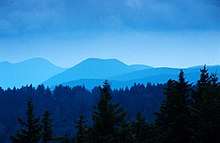
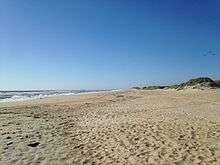
North Carolina provides a large range of recreational activities, from swimming at the beach to skiing in the mountains. North Carolina offers fall colors, freshwater and saltwater fishing, hunting, birdwatching, agritourism, ATV trails, ballooning, rock climbing, biking, hiking, skiing, boating and sailing, camping, canoeing, caving (spelunking), gardens, and arboretums. North Carolina has theme parks, aquariums, museums, historic sites, lighthouses, elegant theaters, concert halls, and fine dining.[118][119]
North Carolinians enjoy outdoor recreation utilizing numerous local bike paths, 34 state parks, and 14 national parks. National Park Service units include the Appalachian National Scenic Trail, the Blue Ridge Parkway, Cape Hatteras National Seashore, Cape Lookout National Seashore, Carl Sandburg Home National Historic Site at Flat Rock, Fort Raleigh National Historic Site at Manteo, Great Smoky Mountains National Park, Guilford Courthouse National Military Park in Greensboro, Moores Creek National Battlefield near Currie in Pender County, the Overmountain Victory National Historic Trail, Old Salem National Historic Site in Winston-Salem, the Trail of Tears National Historic Trail, and Wright Brothers National Memorial in Kill Devil Hills. National Forests include Uwharrie National Forest in central North Carolina, Croatan National Forest in Eastern North Carolina, Pisgah National Forest in the western mountains, and Nantahala National Forest in the southwestern part of the state.
Arts and culture
North Carolina has traditions in art, music, and cuisine. The nonprofit arts and culture industry generates $1.2 billion in direct economic activity in North Carolina, supporting more than 43,600 full-time equivalent jobs and generating $119 million in revenue for local governments and the state of North Carolina.[120] North Carolina established the North Carolina Museum of Art as the first major museum collection in the country to be formed by state legislation and funding[121] and continues to bring millions into the NC economy.[122] Also see this list of museums in North Carolina.
One of the more famous arts communities in the state is Seagrove, the handmade-pottery capital of the U.S., where artisans create handcrafted pottery inspired by the same traditions that began in this community more than 200 years ago..
Music
North Carolina boasts a large number of noteworthy jazz musicians, some among the most important in the history of the genre. These include: John Coltrane, (Hamlet, High Point); Thelonious Monk (Rocky Mount); Billy Taylor (Greenville); Woody Shaw (Laurinburg); Lou Donaldson (Durham); Max Roach (Newland); Tal Farlow (Greensboro); Albert, Jimmy and Percy Heath (Wilmington); Nina Simone (Tryon); and Billy Strayhorn (Hillsborough).
.jpg)
North Carolina is also famous for its tradition of old-time music, and many recordings were made in the early 20th century by folk-song collector Bascom Lamar Lunsford. Musicians such as the North Carolina Ramblers helped solidify the sound of country music in the late 1920s, while the influential bluegrass musician Doc Watson also hailed from North Carolina. Both North and South Carolina are hotbeds for traditional rural blues, especially the style known as the Piedmont blues.
Ben Folds Five originated in Winston-Salem, and Ben Folds still records and resides in Chapel Hill.
The British band Pink Floyd is named, in part, after Chapel Hill bluesman Floyd Council.
The Research Triangle area has long been a well-known center for folk, rock, metal, jazz and punk.[123] James Taylor grew up around Chapel Hill, and his 1968 song "Carolina in My Mind" has been called an unofficial anthem for the state.[124][125][126] Other famous musicians from North Carolina include J. Cole, Shirley Caesar, Roberta Flack, Clyde McPhatter, Nnenna Freelon, Warren Haynes, Jimmy Herring, Michael Houser, Eric Church, Future Islands, Randy Travis, Ryan Adams, Ronnie Milsap, Anthony Hamilton, The Avett Brothers and Luke Combs.
Metal and punk acts such as Corrosion of Conformity, Between the Buried and Me, and Nightmare Sonata are native to North Carolina.
EDM producer Porter Robinson hails from Chapel Hill.
North Carolina is the home of more American Idol finalists than any other state: Clay Aiken (season two), Fantasia Barrino (season three), Chris Daugherty (season five), Kellie Pickler (season five), Bucky Covington (season five), Anoop Desai (season eight), Scotty McCreery (season ten), and Caleb Johnson (season thirteen). North Carolina also has the most American Idol winners with Barrino, McCreery, and Johnson.
In the mountains, the Brevard Music Center hosts choral, operatic, orchestral, and solo performances during its annual summer schedule.
North Carolina has five professional opera companies: Opera Carolina in Charlotte, NC Opera in Raleigh, Greensboro Opera in Greensboro, Piedmont Opera in Winston-Salem, and Asheville Lyric Opera in Asheville. Academic conservatories and universities also produce fully staged operas, such as the A. J. Fletcher Opera Institute of the University of North Carolina School of the Arts in Winston-Salem, the Department of Music of the University of North Carolina at Chapel Hill, and UNC Greensboro.
Among others, there are three high-level symphonic orchestras: NC Symphony in Raleigh, Charlotte Symphony, and Winston-Salem Symphony. The NC Symphony holds the North Carolina Master Chorale. The Carolina Ballet is headquartered in Raleigh, and there is also the Charlotte Ballet.
The state boasts three performing arts centers: DPAC in Durham, Duke Energy Center for the Performing Arts in Raleigh, and the Blumenthal Performing Art Centers in Charlotte. They feature concerts, operas, recitals, and traveling Broadway musicals.
Hip-hop artists DaBaby and J. Cole hail from North Carolina.
Also, see the North Carolina Music Hall of Fame.
Shopping
North Carolina has a variety of shopping choices. SouthPark Mall in Charlotte is currently the largest in the Carolinas, with almost 2.0 million square feet. Other major malls in Charlotte include Northlake Mall and Carolina Place Mall in nearby suburb Pineville. Other major malls throughout the state include Hanes Mall in Winston-Salem, North Carolina, The Thruway Center in Winston-Salem, North Carolina, Crabtree Valley Mall, North Hills Mall, and Triangle Town Center in Raleigh; Friendly Center and Four Seasons Town Centre in Greensboro; Oak Hollow Mall in High Point; Concord Mills in Concord; Valley Hills Mall in Hickory; Cross Creek Mall in Fayetteville; and The Streets at Southpoint and Northgate Mall in Durham and Independence Mall in Wilmington, North Carolina, and Tanger Outlets in Charlotte, Nags Head, Blowing Rock, and Mebane, North Carolina.
Cuisine and agriculture
A culinary staple of North Carolina is pork barbecue. There are strong regional differences and rivalries over the sauces and methods used in making the barbecue. The common trend across Western North Carolina is the use of premium grade Boston butt. Western North Carolina pork barbecue uses a tomato-based sauce, and only the pork shoulder (dark meat) is used. Western North Carolina barbecue is commonly referred to as Lexington barbecue after the Piedmont Triad town of Lexington, home of the Lexington Barbecue Festival, which attracts more than 100,000 visitors each October.[127][128] Eastern North Carolina pork barbecue uses a vinegar-and-red-pepper-based sauce and the "whole hog" is cooked, thus integrating both white and dark meat.
Krispy Kreme, an international chain of doughnut stores, was started in North Carolina; the company's headquarters are in Winston-Salem. Pepsi-Cola was first produced in 1898 in New Bern. A regional soft drink, Cheerwine, was created and is still based in the city of Salisbury. Despite its name, the hot sauce Texas Pete was created in North Carolina; its headquarters are also in Winston-Salem. The Hardee's fast-food chain was started in Rocky Mount. Another fast-food chain, Bojangles', was started in Charlotte, and has its corporate headquarters there. A popular North Carolina restaurant chain is Golden Corral. Started in 1973, the chain was founded in Fayetteville, with headquarters located in Raleigh. Popular pickle brand Mount Olive Pickle Company was founded in Mount Olive in 1926. Fast casual burger chain Hwy 55 Burgers, Shakes & Fries also makes its home in Mount Olive. Cook Out, a popular fast-food chain featuring burgers, hot dogs, and milkshakes in a wide variety of flavors, was founded in Greensboro in 1989 and has begun expanding outside of North Carolina. In 2013, Southern Living named Durham–Chapel Hill the South's "Tastiest City".
Over the last decade, North Carolina has become a cultural epicenter and haven for internationally prize-winning wine (Noni Bacca Winery), internationally prized cheeses (Ashe County), "L'institut International aux Arts Gastronomiques: Conquerront Les Yanks les Truffes, January 15, 2010" international hub for truffles (Garland Truffles), and beer making, as tobacco land has been converted to grape orchards while state laws regulating alcohol content in beer allowed a jump in ABV from 6% to 15%. The Yadkin Valley in particular has become a strengthening market for grape production, while Asheville recently won the recognition of being named 'Beer City USA'. Asheville boasts the largest number of breweries per capita of any city in the United States. Recognized and marketed brands of beer in North Carolina include Highland Brewing, Duck Rabbit Brewery, Mother Earth Brewery, Weeping Radish Brewery, Big Boss Brewing, Foothills Brewing, Carolina Brewing Company, Lonerider Brewing, and White Rabbit Brewing Company.
North Carolina has large grazing areas for beef and dairy cattle. Truck farms can be found in North Carolina. A truck farm is a small farm where fruits and vegetables are grown to be sold at local markets. The state's shipping, commercial fishing, and lumber industries are important to its economy. Service industries, including education, health care, private research, and retail trade, are also important. Research Triangle Park, a large industrial complex located in the Raleigh-Durham area, is one of the major centers in the country for electronics and medical research.
Tobacco was one of the first major industries to develop after the Civil War. Many farmers grew some tobacco, and the invention of the cigarette made the product especially popular. Winston-Salem is the birthplace of R. J. Reynolds Tobacco Company (RJR), founded by R. J. Reynolds in 1874 as one of 16 tobacco companies in the town. By 1914 it was selling 425 million packs of Camels a year. Today it is the second-largest tobacco company in the U.S. (behind Altria Group). RJR is an indirect wholly owned subsidiary of Reynolds American Inc., which in turn is 42% owned by British American Tobacco.[129]
Ships named for the state
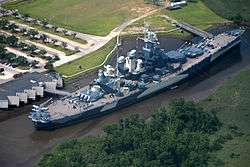
Several ships have been named after the state. Most famous is the USS North Carolina, a World War II battleship. The ship served in several battles against the forces of Imperial Japan in the Pacific theater during the war. Now decommissioned, it is part of the USS North Carolina Battleship Memorial in Wilmington. Another USS North Carolina, a nuclear attack submarine, was commissioned in Wilmington, North Carolina, on May 3, 2008.[130]
State parks
The state maintains a group of protected areas known as the North Carolina State Park System, which is managed by the North Carolina Division of Parks & Recreation (NCDPR), an agency of the North Carolina Department of Environment and Natural Resources (NCDENR).
State symbols
- State motto: Esse quam videri ("To be, rather than to seem") (1893)
- State song: "The Old North State" (1927)
- State flower: Dogwood (1941)
- State bird: Cardinal (1943)
- State colors: The red and blue of the N.C. and U.S. flags (1945)
- State toast: "The Tar Heel Toast" (1957)
- State tree: Pine (Pinus) (1963)[131]
- State shell: Scotch bonnet (1965)
- State mammal: Eastern gray squirrel (1969)
- State salt water fish: Red drum (also known as the channel bass) (1971)
- State insect: European honey bee (1973)
- State gemstone: Emerald (1973)
- State reptile: Eastern box turtle (1979)
- State rock: Granite (1979)
- State beverage: Milk (1987)
- State historical boat: Shad boat (1987)
- State language: English (1987)
- State dog: Plott Hound (1989)
- State military academy: Oak Ridge Military Academy (1991)
- State tartan: Carolina tartan (1991)[132]
- State vegetable: Sweet potato (1995)
- State red berry: Strawberry (2001)
- State blue berry: Blueberry (2001)
- State fruit: Scuppernong grape (2001)
- State wildflower: Carolina lily (2003)
- State Christmas tree: Fraser fir (2005)
- State carnivorous plant: Venus flytrap (2005)
- State folk dance: Clogging (2005)
- State popular dance: Carolina shag (2005)
- State birthplace of traditional pottery: The Seagrove area (2005)
- State sport: NASCAR (2011)[133]
Armed forces installations
.jpg)
Fort Bragg, near Fayetteville and Southern Pines, is a large and comprehensive military base and is the headquarters of the XVIII Airborne Corps, 82nd Airborne Division, and the U.S. Army Special Operations Command. Serving as the air wing for Fort Bragg is Pope Field, also located near Fayetteville.
Located in Jacksonville, Marine Corps Base Camp Lejeune, combined with nearby bases Marine Corps Air Station (MCAS) Cherry Point, MCAS New River, Camp Geiger, Camp Johnson, Stone Bay and Courthouse Bay, makes up the largest concentration of Marines and sailors in the world. MCAS Cherry Point is home of the 2nd Marine Aircraft Wing. Located in Goldsboro, Seymour Johnson Air Force Base is home of the 4th Fighter Wing and 916th Air Refueling Wing. One of the busiest air stations in the United States Coast Guard is located at the Coast Guard Air Station in Elizabeth City. Also stationed in North Carolina is the Military Ocean Terminal Sunny Point in Southport.
On January 24, 1961, a B-52G broke up in midair and crashed after suffering a severe fuel loss, near Goldsboro, dropping two nuclear bombs in the process without detonation.[134] In 2013, it was revealed that three safety mechanisms on one bomb had failed, leaving just one low-voltage switch preventing detonation.[135]
See also
- Index of North Carolina-related articles
- Outline of North Carolina
References
- In 1893 the North Carolina General Assembly adopted the Latin words "Esse Quam Videri" as the state motto and directed that these words be placed with the state's Coat of Arms and the date "20 May 1775" upon the great seal.
- "North Carolina Climate and Geography". NC Kids Page. North Carolina Department of the Secretary of State. May 8, 2006. Archived from the original on November 4, 2006. Retrieved November 7, 2006.
- "Elevations and Distances in the United States". United States Geological Survey. 2001. Archived from the original on October 15, 2011. Retrieved October 24, 2011.
- Elevation adjusted to North American Vertical Datum of 1988.
- "Median Annual Household Income". The Henry J. Kaiser Family Foundation. Archived from the original on December 20, 2016. Retrieved December 8, 2016.
- "State language". Ncga.state.nc.cus. p. § 145–12. Retrieved May 23, 2016.
(a)Purpose. English is the most common language of the people of the United States of America and the State of North Carolina. This section is intended to preserve, protect and strengthen the English language, and not to supersede any of the rights guaranteed to the people by the Constitution of the United States or the Constitution of North Carolina. (b) English as the Official Language of North Carolina. English is the official language of the State of North Carolina.
- "North Carolina". Modern Language Association. Archived from the original on June 4, 2013. Retrieved August 11, 2012.
- Roberts, Deon (November 15, 2018). "Charlotte regains its place as No. 2 U.S. banking center. Will it keep it?". The Charlotte Observer. Archived from the original on November 21, 2018. Retrieved December 1, 2018.
- Richter, William L. (William Lee), 1942- (2009). The A to Z of the Civil War and Reconstruction. Richter, William L. (William Lee), 1942-. Lanham: Scarecrow Press. ISBN 978-0-8108-6336-1. OCLC 435767707.CS1 maint: multiple names: authors list (link)
- "Mount Mitchell State Park". Archived from the original on November 20, 2010. Retrieved November 7, 2010.
- "North Carolina American Indian History Time Line". North Carolina Museum of History. Archived from the original on September 15, 2016. Retrieved September 14, 2016.
- Richards, Constance E. (Spring 2008). "Contact and Conflict" (PDF). American Archaeology. p. 14. Archived (PDF) from the original on June 24, 2009. Retrieved June 26, 2008.
- "Blackbeard killed off North Carolina". History.com. February 9, 2010. Archived from the original on April 1, 2015. Retrieved April 30, 2015.
- D. Moore. (1997) "A General History of Blackbeard the Pirate, the Queen Anne's Revenge and the Adventure". In Tributaries, Volume VII, 1997. pp. 31–35. (North Carolina Maritime History Council).
- North Carolina Department of Cultural Resources. "Capitol History". Archived from the original on October 29, 2013. Retrieved May 16, 2013.
- Wiki Article Historical Demography of the United States.
- Milton Ready, The Tar Heel State: A History of North Carolina (U. of South Carolina Press, 2005), pp. 116, 120.
- "Chapter 5" Archived March 21, 2009, at the Wayback Machine, 1898 Wilmington Race Riot Commission Report, North Carolina Dept. of Cultural Resources.
- Richard H. Pildes, "Democracy, Anti-Democracy, and the Canon", Constitutional Commentary, Vol.17, 2000, p. 27 Archived November 21, 2018, at the Wayback Machine. Retrieved March 10, 2008.
- Pildes (2000), "Democracy, Anti-Democracy, and the Canon", pp. 12–13.
- Patrick Gibbs; Moore, David G.; Beck Jr., Robin A.; Rodning, Christopher B. (March 2004). "Joara and Fort San Juan: culture contact at the edge of the world". Antiquity.ac.uk. Archived from the original on July 24, 2011. Retrieved July 24, 2011.
- Randinelli, Tracey. Tanglewood Park. Orlando, Florida: Harcourt. p. 16. ISBN 978-0-15-333476-4.
- "North Carolina State Library—North Carolina History". Statelibrary.dcr.state.nc.us. Archived from the original on February 5, 2009. Retrieved July 24, 2011.
- "Cherokee Indians". Uncpress.unc.edu. November 16, 1919. Archived from the original on July 26, 2011. Retrieved July 24, 2011.
- Russell Thornton (1990) American Indian Holocaust and Survival: A Population History since 1492 Archived January 8, 2016, at the Wayback Machine, University of Oklahoma Press. p.79. ISBN 0-8061-2220-X
- Fenn and Wood, Natives and Newcomers, pp. 24–25.
- Powell, North Carolina Through Four Centuries, p. 105.
- Lefler and Newsome, (1973).
- Bethune, Lawrence E. "Scots to Colonial North Carolina Before 1775". Lawrence E. Bethune's M.U.S.I.C.s Project. Archived from the original on February 19, 2012. Retrieved October 26, 2011.
- "Ancestry of the Population by State: 1980—Table 3a—Persons Who Reported a Single Ancestry Group for Regions, Divisions and States" (PDF). Archived (PDF) from the original on August 30, 2019. Retrieved May 11, 2012.
- "Table 1. Type of Ancestry Response for Regions, Divisions and States: 1980" (PDF). Archived (PDF) from the original on July 8, 2019. Retrieved May 11, 2012.
- "Indentured Servitude in Colonial America". Webcitation.org. Archived from the original on October 22, 2009. Retrieved May 11, 2012.
- "Paul Heinegg, Free African Americans in Virginia, North Carolina, South Carolina, Maryland and Delaware". Freeafricanamericans.com. Archived from the original on August 7, 2010. Retrieved July 24, 2011.
- Stonestreet, Ottis C. IV, The Battle of Cowan's Ford: General Davidson's Stand on the Catawba River and its place in North Carolina History (CreateSpace Publishing 2012) ISBN 978-1-4680-7730-8 p. 3.
- Paul Heinegg, Free African Americans in Virginia, North Carolina, South Carolina, Maryland and Delaware Archived September 19, 2012, at the Wayback Machine, 2005.
- John Hope Franklin, Free Negroes of North Carolina, 1789–1860, Chapel Hill: University of North Carolina Press, 1941, reprint, 1991.
- "NC Business History—Railroads". Historync.org. Archived from the original on July 26, 2011. Retrieved July 24, 2011.
- "Historical Census Browser:Census Data for Year 1860". University of Virginia Library. 2004. Archived from the original on October 11, 2014. Retrieved June 26, 2014.
- Morris, Thomas D. (1999). Southern Slavery and the Law, 1619–1860. University of North Carolina Press. p. 172. ISBN 978-0-8078-6430-2. Archived from the original on October 25, 2015. Retrieved October 17, 2015.
- "Center for Civic Education—Lincoln Bicentennial with Supplemental Lesson: Timeline". Civiced.org. Archived from the original on July 19, 2011. Retrieved July 24, 2011.
- "Highlights: Secession". Docsouth.unc.edu. Archived from the original on September 16, 2011. Retrieved July 24, 2011.
- "Today in History: June 8". Memory.loc.gov. April 9, 1959. Archived from the original on May 14, 2011. Retrieved July 24, 2011.
- "Civil War Facts About North Carolina". ClassBrain.com. June 28, 2006. Archived from the original on July 23, 2011. Retrieved July 24, 2011.
- "Census Regions and Divisions of the United States" (PDF). United States Census Bureau, Geography Division. Archived (PDF) from the original on December 19, 2017. Retrieved December 15, 2018.
- "Blackbeard's Queen Anne's Revenge Coming Back to Beaufort". Beach Carolina Magazine. March 30, 2011. Archived from the original on February 21, 2013.
- "People of North Carolina". North Carolina State Board of Education. Archived from the original on August 8, 2016. Retrieved August 7, 2016.
- "Facts About North Carolina Mountains". USA Today. Archived from the original on August 19, 2016. Retrieved August 7, 2016.
- "Facts for North Carolina's Mountain Region". Economic Development Partnership of North Carolina. January 21, 2011. Archived from the original on August 12, 2016. Retrieved August 8, 2016.
- "Elevations and Distances in the United States". U.S Geological Survey. April 29, 2005. Archived from the original on January 16, 2008. Retrieved November 6, 2006.
- "North Carolina River Basins". North Carolina Wildlife Resources Commission. Archived from the original on September 29, 2016. Retrieved August 7, 2016.
- "River Basin Interactive Map". NC Office of Environmental Education. Archived from the original on April 11, 2014. Retrieved June 10, 2014.
- "Overview". State Climate Office of North Carolina. Archived from the original on July 31, 2016. Retrieved August 7, 2016.
- "Severe Weather—Summer Storms". North Carolina Department of Transportation. Archived from the original on August 15, 2016. Retrieved August 7, 2016.
- "Atlantic hurricane best track (HURDAT version 2)" (Database). United States National Hurricane Center. May 25, 2020.
- John Hairr (2008). The Great Hurricanes of North Carolina. pp. 139–150.
- "NOAA National Climatic Data Center". Archived from the original on October 16, 2011. Retrieved October 24, 2006.
- "April 16, 2011 North Carolina Tornado Outbreak". National Weather Service. February 3, 2012. Archived from the original on August 7, 2016. Retrieved August 7, 2016.
- "North Carolina's largest tornado outbreak—April 16, 2011". US Tornadoes. April 16, 2013. Archived from the original on August 8, 2016. Retrieved August 7, 2016.
- "NowData—NOAA Online Weather Data". National Oceanic and Atmospheric Administration. Retrieved December 16, 2011.
- "NOWData—NOAA Online Weather Data". National Oceanic and Atmospheric Administration. Retrieved December 4, 2012.
- "NOWData—NOAA Online Weather Data". National Oceanic and Atmospheric Administration. Retrieved April 14, 2012.
- "Climate Data—NWS Raleigh North Carolina". National Oceanic and Atmospheric Administration. Retrieved September 6, 2019.
- "NowData—NOAA Online Weather Data". National Oceanic and Atmospheric Administration. Retrieved February 26, 2012.
- Resident Population Data. "Resident Population Data—2010 Census". 2010.census.gov. Archived from the original on December 20, 2012. Retrieved December 22, 2012.
- "QuickFacts North Carolina; UNITED STATES". 2019 Population Estimates. United States Census Bureau, Population Division. February 19, 2020. Archived from the original on December 30, 2018. Retrieved February 19, 2020.
- Data Access and Dissemination Systems (DADS). "American FactFinder—Results". census.gov. Archived from the original on December 18, 2012. Retrieved May 29, 2012.
- "2010 Census" (PDF). US Census. Archived (PDF) from the original on September 11, 2011. Retrieved August 21, 2011.
- Population Division, Laura K. Yax. "Historical Census Statistics on Population Totals By Race, 1790 to 1990, and By Hispanic Origin, 1970 to 1990, For The United States, Regions, Divisions, and States". Archived from the original on July 25, 2008. Retrieved January 5, 2015.
- "Population of North Carolina: Census 2010 and 2000 Interactive Map, Demographics, Statistics, Quick Facts".
- Center for New Media and Promotions(C2PO). "2010 Census Data". Retrieved January 5, 2015.
- "North Carolina". Modern Language Association. Archived from the original on December 1, 2007. Retrieved August 16, 2013.
- "Cherokee". Ethnologue. Archived from the original on July 30, 2015. Retrieved April 11, 2014.
- "Religion in America: U.S. Religious Data, Demographics and Statistics—Pew Research Center". Archived from the original on December 10, 2017. Retrieved December 9, 2017.
- Brooks, Walter Henderson (1851–1945) (January 1922). "The Evolution of the Negro Baptist Church". Journal of Negro History. 7 (1): 11–22. doi:10.2307/2713578. JSTOR 2713578. Archived from the original on August 30, 2019. Retrieved May 19, 2019.
- Albert J. Raboteau, Slave Religion: The "Invisible Institution" in the Antebellum South, New York: Oxford University Press, 1979
- Wilson Fallin Jr., Uplifting the People: Three Centuries of Black Baptists in Alabama (2007) pp. 52–53
- "North Carolina: Religious Traditions". State Membership Report. Association of Religious Data Archives. 2010. Archived from the original on December 17, 2013. Retrieved June 10, 2014.
- Whitsell, Robin (February 26, 2008). "Religiously-Affiliated North Carolina Colleges". Carolina Parent. Archived from the original on October 29, 2013. Retrieved June 10, 2014.
- "Annual Estimates of the Resident Population for Counties: April 1, 2010, to July 1, 2015—U.S. Census Bureau". Census.gov. Archived from the original on June 6, 2016. Retrieved May 19, 2016.
- "Biggest US Cities By Population—North Carolina 2018 Populations". biggestuscities.com. Retrieved February 19, 2020.
- "Biggest US Cities By Population—North Carolina 2018 Populations". U.S. Census Bureau. July 1, 2018. Archived from the original on January 17, 2019. Retrieved February 19, 2020.
- "Metropolitan and Micropolitan Statistical Areas Population Totals: 2010–2018". U.S. Census Bureau. February 19, 2020. Retrieved February 19, 2020.
- "Real Gross Domestic Product (GDP) of the federal state of North Carolina from 1997 to 2018 (in billion U.S. dollars)". Statista. Archived from the original on October 27, 2019. Retrieved September 9, 2019.
- "U.S. Population in Poverty Percentage State Rank Based on ACS 2010–2014 data". Usa.com. Archived from the original on September 11, 2017. Retrieved July 14, 2017.
- "Crop Profile for Tobacco in North Carolina" (PDF). Regional IPM Centers. December 2015. Archived (PDF) from the original on January 19, 2019. Retrieved January 17, 2019.
- "GDP by State". Greyhill Advisors. Archived from the original on February 3, 2012. Retrieved September 7, 2011.
- "Local & North Carolina state news from Raleigh, NC—NewsObserver.com". Archived from the original on March 8, 2014. Retrieved January 5, 2015.
- "The 19th worst state" (PDF). Truth in Accounting. Archived (PDF) from the original on March 5, 2014. Retrieved February 27, 2014.
- "About NC". State of North Carolina. Archived from the original on August 17, 2016. Retrieved August 7, 2016.
- "North Carolina Agriculture". State Library of North Carolina. Archived from the original on August 11, 2016. Retrieved August 7, 2016.
- "States by Total Trees Harvested" (PDF). National Christmas Tree Association. Archived (PDF) from the original on October 18, 2016. Retrieved August 7, 2016.
- "About the Census". United States Department of Agriculture. Archived from the original on August 19, 2016. Retrieved August 7, 2016.
- Economy at a Glance Archived August 11, 2011, at the Wayback Machine. For North Carolina. U.S. Bureau of Labor Statistics. 2011.
- "Site Selection Rankings". Greyhill Advisors. Archived from the original on November 6, 2011. Retrieved October 17, 2011.
- Doran, Will; Raynor, David (October 8, 2016). "NC economy a mixed bag". Raleigh News & Observer. Archived from the original on June 2, 2017. Retrieved September 3, 2017.)
- "NC Department of Transportation Article: North Carolina's Future Rides on Us". NC Department of Transportation. Archived from the original on September 20, 2012. Retrieved September 22, 2012.
- World's busiest airports by passenger traffic#2013 statistics
- Leip, David. "General Election Results—North Carolina". United States Election Atlas. Archived from the original on July 9, 2018. Retrieved November 18, 2016.
- "Voter Registration Statistics". North Carolina State Board of Elections.
- Stohr, Greg; McCartney, Allison (March 22, 2019). "The Supreme Court Has Never Struck Down a Partisan Voter Map. Will North Carolina's Be the First?". Bloomberg. Archived from the original on May 17, 2019. Retrieved May 19, 2019.
- "Mark Harris calls for new election in 9th district". newsobserver. Archived from the original on May 17, 2019. Retrieved February 21, 2019.
- "North Carolina Public Schools". Ncpublicschools.org. Archived from the original on February 4, 2012. Retrieved January 31, 2012.
- "NC Public School Facts". Ncpublicschools.org. Archived from the original on July 6, 2011. Retrieved July 24, 2011.
- "K-12 Standards, Curriculum, and Instruction". North Carolina State Board of Education. Archived from the original on August 16, 2016. Retrieved August 7, 2016.
- North Carolina School District Demographics Archived April 25, 2013, at the Wayback Machine. Proximityone.com. Retrieved July 12, 2013.
- "NC DPI: Schools". www.dpi.nc.gov.
- "History and Traditions". unc.edu. University of North Carolina at Chapel Hill. Retrieved April 21, 2020.
- The University of North Carolina. "Our 17 Institutions". Archived from the original on January 7, 2012. Retrieved January 5, 2012.
- NC State University. "About NC State:Discovery begins at NC State". Archived from the original on January 3, 2012. Retrieved January 5, 2012.
- "Duke University: A brief narrative History". library.duke.edu. Duke University. Retrieved April 21, 2020.
- "History". about.wfu.edu. Wake Forest University. Retrieved April 21, 2020.
- "Search of Library of Congress for North Carolina newspapers currently in publiication". Library of Congress. Retrieved January 7, 2020.
- "NJCAA". NJCAA. Archived from the original on April 6, 2019. Retrieved August 22, 2019.
- "Archived copy". Archived from the original on November 1, 2019. Retrieved November 1, 2019.CS1 maint: archived copy as title (link)
- "Stats Report Viewer". nps.gov. Archived from the original on January 18, 2015. Retrieved January 18, 2015.
- "All About Asheville". ashevilleguidebook.com. Archived from the original on February 2, 2015. Retrieved January 18, 2015.
- Kate Rinsema. "The United States' happiest places [infographic]—Holy Kaw!". Holy Kaw!. Archived from the original on January 18, 2015.
- "North Carolina Vacation Rentals". iGOvacation. Archived from the original on January 11, 2008. Retrieved July 12, 2013.
- "What To Do Across North Carolina". VisitNC.com. 2006. Archived from the original on December 1, 2006. Retrieved December 18, 2006.
- "North Carolina Arts Council". Ncarts.org. Archived from the original on July 16, 2017. Retrieved July 14, 2017.
- "North Carolina Museum of Art Museum Backgrounder" (PDF). Ncartmuseum.org. Archived from the original (PDF) on October 19, 2012. Retrieved July 14, 2017.
- "N.C. Museum of Art: Rembrandt Exhibit Pumped $13 Million Into Wake County Economy". SGR Today. Archived from the original on October 18, 2012. Retrieved November 11, 2012.
- Unterberger, Richie (1999). Music USA: The Rough Guide. The Rough Guides. ISBN 978-1-85828-421-7.
- "Hey, James Taylor—You've got a ... bridge?". Rome News-Tribune. May 21, 2002. Archived from the original on January 31, 2011. Retrieved June 28, 2009.
- Hoppenjans, Lisa (October 2, 2006). "You must forgive him if he's ..." The News & Observer. Retrieved June 28, 2009.
- Waggoner, Martha (October 17, 2008). "James Taylor to play 5 free NC concerts for Obama". USA Today. Associated Press. Archived from the original on May 24, 2010. Retrieved June 28, 2009.
- Garner, Bob (2007). Bob Garner's Guide to North Carolina Barbecue. John F. Blair, Publisher. ISBN 978-0-89587-254-8.
- Craig, H. Kent (2006). "What is North Carolina-Style BBQ?". ncbbq.com. Archived from the original on April 13, 2010. Retrieved February 15, 2010.
- Nannie M. Tilley, The R.J. Reynolds Tobacco Company (2009).
- "USS North Carolina 'brought to life' again". WRAL-TV. May 3, 2008. Archived from the original on June 13, 2011. Retrieved February 4, 2010.
- "General Assembly of North Carolina". Archived from the original on May 25, 2016. Retrieved November 8, 2016.
- "Secretary of State of North Carolina". Archived from the original on July 18, 2011. Retrieved July 24, 2011.
- "NASCAR made North Carolina's official state sport". SportingNews.com. June 21, 2011. Archived from the original on May 14, 2012. Retrieved January 26, 2012.
- Schneider, Barry. "Big Bangs from little bombs". Bulletin of the Atomic Scientists, May 1975, p. 28.
- "USAF Atomic Bomb in North Carolina 1961" Archived December 1, 2016, at the Wayback Machine, The Guardian, September 20, 2013
Bibliography
- Lefler, Hugh (numerous editions since 1934). North Carolina History Told by Contemporaries . University of North Carolina Press.
- Jones, H. G. (1984). North Carolina Illustrated, 1524–1984. University of North Carolina Press.
- North Carolina Manual. Published biennially by the Department of the Secretary of State since 1941.
- The Religion in North Carolina Digital Collection. A grant-funded project to provide digital access to publications of and about religious bodies in North Carolina. Partner institutions at Duke University, UNC-Chapel Hill, and Wake Forest University contributed the largest portion of the items in this collection, but the collection is enriched by unique materials from libraries and archives throughout North Carolina. The materials in this collection include local church histories, periodicals, clergy biographies, cookbooks, event programs, directories, and much more.
Further reading
- James, Clay; Orr, Douglas, eds. (1971). North Carolina Atlas: Portrait of a Changing Southern State.
- Christensen, Rob (2008). The Paradox of Tar Heel Politics. Chapel Hill: University of North Carolina Press.
- Cooper, Christopher A.; Knotts, H. Gibbs, eds. (2008). The New Politics of North Carolina. Chapel Hill: University of North Carolina Press.
- Crow; Jeffrey J.; Tise, Larry E. (1979). Writing North Carolina History. Online.
- Eamon, Tom (2014). The Making of a Southern Democracy: North Carolina Politics from Kerr Scott to Pat McCrory. Chapel Hill, North Carolina: University of North Carolina Press.
- Fleer, Jack D. (1994). North Carolina Government & Politics. Online political science textbook.
- Hawks, Francis L. (1857). History of North Carolina, Volumes I and II.
- Kersey, Marianne M.; Coble, Ran, eds. (1989). North Carolina Focus: An Anthology on State Government, Politics, and Policy. 2d ed. Raleigh: North Carolina Center for Public Policy Research.
- Lefler, Hugh Talmage (1963). A Guide to the Study and Reading of North Carolina History. Online.
- Lefler, Hugh Talmage; Newsome, Albert Ray (1954, 1963, 1973). North Carolina: The History of a Southern State. Standard textbook.
- Link, William A. (2009). North Carolina: Change and Tradition in a Southern State. History by leading scholar.
- Luebke, Paul (1990). Tar Heel Politics: Myths and Realities.
- Powell, William S. (1979–88). Dictionary of North Carolina Biography. Vol. 1, A-C; vol. 2, D-G; vol. 3, H-K.
- Powell, William S. (1958). North Carolina Fiction, 1734–1957: An Annotated Bibliography.
- Powell, William S. (1989). North Carolina through Four Centuries. Standard textbook.
- Powell, William S.; Mazzocchi, Jay, eds. (2006). Encyclopedia of North Carolina.
- Ready, Milton. (2005). The Tar Heel State: A History of North Carolina.
- Thuesen, Sarah Caroline. (2013). Greater Than Equal: African American Struggles for Schools and Citizenship in North Carolina, 1919–1965. Chapel Hill, North Carolina: University of North Carolina Press.
- WPA Federal Writers' Project (1939). North Carolina: A Guide to the Old North State. Famous WPA guide to every town.
External links
History
Government and education
- North Carolina state government
- North Carolina state library
- Energy & Environmental Data for North Carolina
- USGS real-time, geographic, and other scientific resources of North Carolina
- North Carolina facts from U.S. Department of Agriculture ERS
- North Carolina Court System official site
- North Carolina facts from U.S. Census Bureau
- NC ECHO—North Carolina Exploring Cultural Heritage Online
- North Carolina Collection, University of North Carolina at Chapel Hill
- Green 'N' Growing: The History of Home Demonstration and 4-H Youth Development in North Carolina hosted by NCSU Libraries Special Collections Research Center
- NC Office of Archives and History
- Commemorative Landscapes of North Carolina
- Driving Through Time: The Blue Ridge Parkway in North Carolina
- The Religion in North Carolina Digital Collection
Other

| Preceded by New York |
List of U.S. states by date of admission to the Union Ratified Constitution on November 21, 1789 (12th) |
Succeeded by Rhode Island |
